#agathocles ii
Explore tagged Tumblr posts
Note
Here's what we did today in calculus II ❤️❤️❤️i love this subject more than my life. Not more than Sofi and Agathocles but a close third



I'm glad that you like it so much!! Your notes seem very thorough, I applaud you for them
0 notes
Photo

Euthydémides
Les Euthydémides étaient une dynastie gréco-bactrienne et indo-grecque d'environ 25 rois, nommée d'après son fondateur Euthydème Ier. La dynastie perdura entre environ 230 av. J.-C. et 10 av. J.-C., d'après les preuves numismatiques. Les emblèmes numismatiques qui caractérisent le plus cette dynastie sont Athéna Alkidemos (Défenseur des peuples) et Héraklès. Euthydème, devint roi en renversant le roi gréco-bactrien Diodote II vers 230 av. J.-C. Il réussit ensuite à résister au roi séleucide Antiochos III qui finit par reconnaître Euthydème comme roi de Bactriane. Lui et son fils Démétrios entreprirent de conquérir l'Inde et devinrent ainsi célèbres. Ils sont mentionnés par les historiens classiques grecs et latins, tandis que leurs successeurs étaient divisés depuis 190 av. J.-C. et, à quelques exceptions près, comme les premiers rois indo-grecs Agathocle et Pantaléon, tombèrent dans l'oubli. Vers 171 av. J.-C., la domination des Euthydémides sur les royaumes gréco-bactriens et indo-grecs fut ébranlée par la rébellion d'Eucratide Ier qui conquit rapidement la plupart des régions, à l'exception des domaines du roi Ménandre. Dès lors, les dynasties euthydémide et eucratide se livrèrent une guerre continue qui dura 90 ans et déchira les royaumes gréco-bactrien et indo-grec. Le puissant roi Ménandre réussit à repousser Eucratide en Bactriane vers 155 av. J.-C., mais les Euthydémides ne reprirent jamais complètement le contrôle de la Bactriane. Lorsque les Yuezhi, vers 145 avant J.-C., envahirent la Bactriane, les Eucratides se retirèrent dans les possessions indo-grecques. La présence des Euthydémides en Inde se maintint jusqu'en 80 av. J.-C., date à laquelle les deux dynasties furent affaiblies par le puissant roi indo-saka Mauès. Pour se défendre contre Mauès, une alliance entre les deux dynasties grecques semble avoir été conclue, sous la direction d'Amyntas. Après la mort de Mauès, les preuves numismatiques suggèrent que seuls les Euthydmides régnèrent ensuite sur les royaumes indo-grecs, jusqu'à ce que les preuves de la présence grecque en Inde ne s'estompent vers 10 av. J.-C.
Lire la suite...
0 notes
Photo


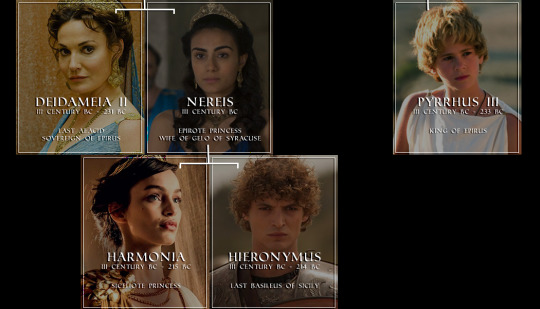
The Epirote descendants of Agathocles of Syracuse and his second wife Alkeia
AGATHOCLES II or AGATHOCLES Junior (Ἀγαθοκλῆς), son Agathocles by his second wife Alkeia. Nothing is known about his life up to the moment his father sent him to Macedonia, at the court of Demetrius I Poliorcetes. This voyage had been organised with the intent to present the younger Agathocles as his father's heir and to form an alliance with Macedonia. Indeed Demetrius received him with all the honours, dressed him in regal robes and gave him splendid gifts. Back in Syracuse the old tyrant officially introduced his son as his successor in front of the people. The younger Agathocles was then sent to the Syracusan encampment, at that time stationed near Etna. Up to that time, the army had been led by Arcagathus, son in turn of the late Arcagathus (not to be confused with the Egyptian one), firstborn of the tyrant. As soon as Arcagathus received his grandfather's order to hand over the army's command to the younger Agathocles, he devised a plan to kill both his grandfather and half-uncle and seize the power. As he instructed his collaborator Menon to poison the tyrant, Arcagathus invited his uncle and, after having got him drunk, murdered him. Agathocles' body was thrown into the sea and, after some time, the tide washed him ashore, where he was recognised and brought to his dying father. Indeed the poison didn't kill immediately the older Agathocles. As soon as the tyrant found out what had happened, he disinherited his grandson and proclaimed as his successor the people of Syracuse, thus abolishing the monarchy and re-established the democracy.
LANASSA (Λάνασσα) see
ALEXANDER II (Αλέξανδρος), son of Pyrrhus I and Lanassa, daughter of the tyrant Agathocles. Alexander succeeded his father as the King of Epirus in 272 BC. He managed to drive Antigonus II Gonatas out of Macedonia, thus finishing his late father's job, but was in turn driven out of his country by Antigonus' son, Demetrius II. Alexander then took refuge among the Acarnians and, with their help and that of his subjects still loyal to him, he recovered Epirus. He married his half-sister Olympias II (daughter of Pyrrhus' first wife, Antigone), who bore him three children: Pyrrhus, Phthia and Ptolemy. Alexander died in 242 BC and was succeeded by his son Phyrrus, although Olympias briefly assumed the regency on account of her sons' young age. She ruled over Macedonia until Pyrrhus reached adulthood.
PYRRHUS II (Πύρρος), son of Alexander II and Olympias II. He succeeded his father when he died in 242 BC, although he effectively started to rule when he reached adulthood. He fathered two daughters (Deidameia and Nereis) with an unnamed woman. Pyrrhus died in 237 BC and was succeeded by his brother Ptolemy.
PHTHIA (Φθια), daughter of Alexander II and Olympias II. Following her father's death, and before 239 BC, Phthia was married by her mother the Regent to Demetrius II of Macedonia. Olympias intended to build up an alliance with Macedonia to contrast the Aetolian League. Nothing else is known about her.
PTOLEMY (Πτολεμαῖος), son of Alexander II and Olympias II. He was called after his late uncle, his mother's full-brother, who probably died in childbirth. Ptolemy succeeded his brother Pyrrhus, but died in 235 BC, after having ruled for three years. He was in the middle of a military expedition when he fell sick and died (although, according to Polyaenus, he was murdered). It is said his mother died soon after of heartbreak since she couldn't bear to lose his sons in such a short period of time. Ptolemy was succeeded by his son, Pyrrhus.
PYRRHUS III (Πύρρος), son of Ptolemy and an unnamed woman. He was only a child when he became King of Epirus, after his father's sudden death. Two years later, Pyrrhus was killed in a coup that had the intent to abolish the monarchy and institute the republic. He was succeeded by his cousin Deidameia.
DEIDAMEIA II or DEIDAMIA (Δηιδάμεια), daughter of Pyrrhus II and an unnamed woman. She succeeded her cousin Pyrrhus III as sovereign of Epirus. Unfortunately for Deidamia, she found herself in the middle of the revolution. She fled to Ambracia and, when offered clemency if she surrendered, she capitulated. She sought refuge in the temple of Artemis as soon as it was clear the Epirotes wouldn't find peace until they were sure they had wiped out the entire royal family. Heedless of the sacrality of the place, the mob killed Deidamia in the sanctuary itself. She was the last Aeacid sovereign of Epirus. After her death, the republic was instituted.
NEREIS (Νηρηΐς) see
HARMONIA (Ἁρμονία) see
HIERONYMUS (῾Ιερώνυμος), son of Gelo of Syracuse and Nereis, daughter of Pyrrhus III of Epirus. Hieronymus was born in Syracuse in 231 BC. After Gelo died in 216 BC, his father, the tyrant Hiero II, named his grandson as his heir. Fearing for Syracuse' fate, Hiero had entrusted his grandson's preparation to numerous tutors, hoping they would correct his weak and (apparently) depraved character. To guide the youngster, at least at the beginning of his rulership, the tyrant had created a council of 15 trusted men, which counted his sons-in-law, Adranodoros and Zoippus. Hiero died in 215 BC and, as he had arranged, he was succeeded by the 15-years old Hieronymus. Polybius describes the new tyrant as “unstable and feather-brained” and, according to the historian, he shocked everyone by marrying a prostitute and giving her the title of queen. The immature tyrant found himself in the middle of the internal strife between the pro-Carthaginian faction and the pro-Roman faction. The former one was represented mainly by Andranodorus and Zoippus, who managed to weaken their enemies and easily manipulated their nephew-in-law. An alliance was agreed between Syracuse and Carthage, represented by Hannibal. According to this treaty, the island of Sicily was going to be ideally divided by the river Himera into two areas. The western part would belong to Carthage, the eastern part to Syracuse. Soon after Hieronymus asked for the western part too and, fearing to lose such an important ally, the Carthaginian caved in. In return, the tyrant had to raise an army and conquer all those Sicilian cities which still hadn't been conquered by either Carthage or Syracuse and were under Rome’s influence. Hieronymus quickly obliged and prepared to Leontinoi, where the pro-Roman faction was dominant. These people feigned to peacefully welcoming him, but while Hieronymus was walking through the city's streets, a group of conspirators attacked him and stabbed him to death. It was 214 BC and Hieronymus had ruled for merely 13 months. He was the last basileus of Sicily. Syracuse will be conquered by Rome in 212 BC.
see here the Egyptian descendants of Agathocles
see here the Syracusan descendants of Agathocles
#history#women#women in history#Agathocles of Syracuse#house of agathocles#agathocles ii#lanassa of syracuse#alexander ii of epirus#pyrrhus ii of epirus#ptolemy of epirus#phthia of epirus#pyrrhus iii of epirus#deidameia ii of epirus#nereis of epirus#Harmonia#hieronymus of syracuse#hiero ii of syracuse#people of sicily#women of sicily#myedit#historyedit#house of hiero ii
33 notes
·
View notes
Text
Esto fue nuestro 2020 en cuanto a material físico se refiere,
Formamos parte de este compilado Francés 🇫🇷
Split Your Mind II (2020) (CD-R Pro)
Junto a:
AFTERSUNDOWN(asd) (IND)
#Baga (BR)
GROG (PT)
Zebú (MX)
¡¡Gracias a United Winds Records!!
También estuvimos en 🤘United Nations of Grindcore 2020☠️
Compilación Internacional de bandas de Grindcore de este 2020 donde estuvimos participando.
Bajo el sello de The Hills Are Dead - Records
Buköwski Grind AbuGhraib, Distaste, Agathocles, INDIGNACION OFICIAL , #BAGA, #CORPSE, Burdizzo, Orden 66, Struggle Session, Líbranos del Mal, Garbage Display, Insistent, Fordærv, Mentor Grind, #Conflicto, Nothing Clean, Jörr, Goatburner, #MutilationOfMind, XSPIG, Vile Species, Septic Agressor, #JACK, #Manfilth, #Downgrade, Bloody $adism band, Wardomized y muchas más
Así como en el International Grindcore Compilation también de The Hills Are Dead - Records
¡Sin duda un 2020 lleno de puro Groovy GrindCore!

8 notes
·
View notes
Text
Belgium playlist

The Allied forces have launched an offense and the strategy is to use Plastic Bertrand. See you in Waterloo! This is the Belgian playlist. Dank u (wel)

Have a listen here: https://www.youtube.com/playlist?list=PL-iHPcxymC19kFE2Ch75otguETyB8yv-0 Have I forgotten a song or band? Blistering barnacles! Let me know. Add your songs.
BELGIQUE 001 Channel Zero - Black Fuel 002 Mijne vlieger - walter de buck 003 AMENRA - Razoreater 004 Hemelbestormer & Vanessa Van Basten - Portal II 005 Brian Eno - The Fat Lady of Limbourg 006 Front 242 - ANIMAL 007 LENG TCH'E - 1-800-Apathy 008 They Might Be Giants - Meet James Ensor 009 Carnation - Explosive cadavers 010 De Vlier - Bezemdans Van Pulle 011 BLIKSEM - Twist the Knife 012 AC/DC - Bedlam In Belgium 013 Lugubrum Trio - Aldi Iacta Est 014 Wolvennest - Tief Unter 015 't Kliekske - Stokkendans 016 Oathbreaker - Immortals 017 Jacques Brel - Ces Gens La 018 Emptiness - Meat Heart 019 Witch Trail - Altered State 020 Mad Curry - Man 021 Iron Maiden - Paschendale 022 Bathsheba - Demon 13 023 WANNES VAN DE VELDE - Pieter Breughel in Brussels 024 HEXA MERA - Inhuman 025 R.Roland - Ethero-Disco 026 Ancient Rites - Mother Europe 027 The Neon Judgement - One Jump Ahead 028 The Casualties - No Turning Back 029 In Bruges Soundtrack-Medieval Waters 030 Pavane La Dona - Tielman Susato - Danserye 031 Nick Cave and the Bad Seeds - Christina the astonishing 032 Zita Swoon - My Bond With You And Your Planet Disco! 033 Die Anarchistische Abendunterhaltung - Drieslagstelsel II 034 BLACK MIRRORS - Funky Queen 035 Hidden Trails - Leaving Like That 036 Eddy Wally Cherie 037 Bobbejaan Schoepen - Cafà Zonder Bier 038 In Bruges Soundtrack-Shootout Part 1 039 De Kreuners - Zo Jong 040 Enthroned - Goatlust 041 Aktarum - Party Troll 042 Black Strike - Rat 043 The Black Tartan Clan - Dont Walk alone 044 Slow Crush - Glow 045 Claude Lombard - Les Enfants Perle 046 chakachas - Jungle Fever 047 Integrity - Hymn for the Children of the Black Flame 048 MANTIS - WELP 049 EXUVIATED - Last Call To The Void 050 Plastic Bertrand - Ca Plane Pour Moi 051 Lais - La Plus Belle de Cans 052 EVIL INVADERS - Raising Hell 053 Brutus - Drive 054 Elg - Panorama 055 Bil Tze - Wing Chun Kung Fu 056 LOTUS - L'Appel du Vide 057 Liquid G. - Selfdestruction 058 LVTHN - Eradication of Nescience 059 Hedonist - The Urge 060 Squash Bowels - Shit Oneself 061 Chakachas - Stories 062 COCAINE PISS - MY CAKE 063 Wolvennest - Void 064 Willem Vermandere - Onderweg 065 Evil shepherd - Darkness engulfs 066 dEUS - Quatre Mains 067 BEAR - Masks 068 Mark Hollander - Aksak Maboul Saure Gurke 069 àGRUMH - Ha People 070 Brutal Sphincter - Big Mouth, Tiny Hands 071 Chapell International with Rene Costy - Scrabble 072 Acid - Maniac 073 Aborted - Die Verzweiflung 074 Ground Nero - Plethora 075 Crossfire - See you in hell 076 O Veux - Strange 077 Marc Moulin - Tohubohu II. 078 Agathocles - cheers mankind cheers 079 Ostrogoth - Queen of desire 080 SLOW - Aurore 081 Perverted Ceremony - Light the inverted candles 082 Plastic Bertrand - Tout petit la planete 083 Brutus - Sugar dragon 084 Bathsheba - At the end of everything 085 Zeus - Held it 086 Possession - Sacerdotium 087 S to S - I'm a Killer 088 Francis Coppieters - Cross Talk 089 Saqra's Cult - Inkarri 090 Butcher - Iron Bitch 091 Dario Mars and the Guillotines - Soulless 092 Whitesnake - Belgian Tom's Hat Trick 093 Integrity - Cradle To The Grave (Motörhead cover) 094 PARAGON IMPURE - Sade II: Juliette, Queen Of Vice 095 ABORTED - Global flatline 096 Serpents Oath - Nihil 097 Red Zebra - I Can't Live in a Living Room 098 ABBA - Waterloo 099 Incredible Bongo Band - Last Bongo in Belgium 100 dEUS - Theme From Turnpike (from In A Bar, Under The Sea) 101 Enthroned - Sine Qua Non 102 Elton John - Just Like Belgium 103 Agathocles - Sieg Shit 104 The Bee Gees - Walking Back to Waterloo 105 Maurice Chevalier - Manneken Pis 111 Schizophrenia - Perpetual Perdition 333 Tintin theme song 666 Channel Zero - Suck My Energy
Grab your Guylian chocolates and have a good time listening. Play the songs here: https://www.youtube.com/playlist?list=PL-iHPcxymC19kFE2Ch75otguETyB8yv-0
#belgium#belgian#Belgian playlist#bands from belgium#belgium playlist#deus#brutus#perverted ceremony#waterloo#iron maiden
5 notes
·
View notes
Photo

DOWNLOAD NICKEL HIGH RES VIDEO LOOP FILE GET 2K ENTIRE 118 DISCOVERED ELEMENTS VISUAL LOOP PACK Nickel is a silvery-white metal with a slight golden tinge that takes a high polish. It is one of only four elements that are magnetic at or near room temperature, the others being iron, cobalt and gadolinium. Its Curie temperature is 355 °C (671 °F), meaning that bulk nickel is non-magnetic above this temperature. The unit cell of nickel is a face-centered cubewith the lattice parameter of 0.352 nm, giving an atomic radius of 0.124 nm. This crystal structure is stable to pressures of at least 70 GPa. Nickel belongs to the transition metals. It is hard, malleable and ductile, and has a relatively high for transition metals electrical and thermal conductivity. The high compressive strength of 34 GPa, predicted for ideal crystals, is never obtained in the real bulk material due to the formation and movement of dislocations; however, it has been reached in Ni nanoparticles. Because the ores of nickel are easily mistaken for ores of silver, understanding of this metal and its use dates to relatively recent times. However, the unintentional use of nickel is ancient, and can be traced back as far as 3500 BCE. Bronzes from what is now Syria have been found to contain as much as 2% nickel. Some ancient Chinese manuscripts suggest that "white copper" (cupronickel, known as baitong) was used there between 1700 and 1400 BCE. This Paktong white copper was exported to Britain as early as the 17th century, but the nickel content of this alloy was not discovered until 1822.Coins of nickel-copper alloy were minted by the Bactrian kings Agathocles, Euthydemus II and Pantaleon in the 2nd Century BCE, possibly out of the Chinese cupronickel. 99.9% nickel five-cent coins were struck in Canada (the world's largest nickel producer at the time) during non-war years from 1922–1981; the metal content made these coins magnetic. During the wartime period 1942–45, most or all nickel was removed from Canadian and US coins to save it for manufacturing armor. Canada used 99.9% nickel from 1968 in its higher-value coins until 2000. The major source of nickel exposure is oral consumption, as nickel is essential to plants. Nickel is found naturally in both food and water, and may be increased by human pollution. For example, nickel-plated faucets may contaminate water and soil; mining and smelting may dump nickel into waste-water; nickel–steel alloy cookware and nickel-pigmented dishes may release nickel into food. The atmosphere may be polluted by nickel ore refining and fossil fuel combustion. Humans may absorb nickel directly from tobacco smoke and skin contact with jewelry, shampoos, detergents, and coins. A less-common form of chronic exposure is through hemodialysis as traces of nickel ions may be absorbed into the plasma from the chelating action of albumin.
#nickel#element#orbit#electron#neutron#proton#animated loop#loop#gif art#science#atom#coin#money#currency#jewelry#contaminant#infections#resistant#decorative#metal#Electrorefining#ore#stainless steel#trihalophosphines
16 notes
·
View notes
Text
June, previously. The end of the month rundown of what was best in June: but in July. June: July. There’s plenty where June came from. Christ’s Kingdom is eternal. June (July)
Was on vacation at the end of last month and forgot to upload this June rundown. So here it is. I’m better than Pitchfork. I’ll fight everyone at Vice HQ. I unearth more underground music than The Wire and The Quietus combined. I’m the best. Down with all with music mags, sites for profit, music content subsidiaries of Old Spice, Monster Energy Beat Camp etc. Bring info exchange to the fans, build the community, Patreons for our celebrated writers, donations for our artists, down with the for-profit content factory. Long live the independent, community-oriented content factory. I’m #1.
Here, this:
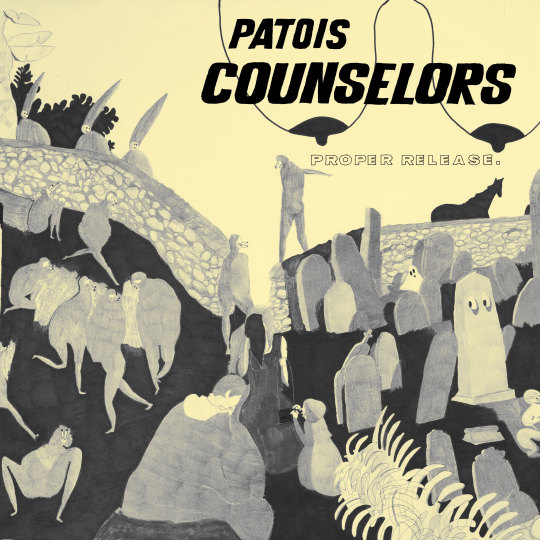
Rock, hard rock, rock music, rock and roll, heavy hard rock
Full-Lengths Acolytes - Rupture LP (Alter) Al Doum & The Faryds - Spirit Rejoin LP (Black Sweat) Alameda 4 - Czarna Woda CD (Instant Classic) Big Blood - Operate Spaceship Earth Properly LP (Feeding Tube) Boyhood - Bad Mantras LP (Shuffling Feet) [nice follow-up to their underappreciated lp from a few years back, although a bit more traditionally pop] Brian Case - Plays Paradise Artificial LP (Hands In The Dark) Chaos Echœs - Mouvement LP (Nuclear War Now!) Danielle Dahl - Loosening Orion's Belt CS (Abstract Tits) Dreebs - Forest of a Crew LP (Ramp Local) The End - Svårmod Och Vemod Är Vardesinnen LP (RareNoise) [complete rager] Eugene Chadbourne, Steve Beresford, Alex Ward - Pleasures Of The Horror LP (Bisou) Flesh Narc - Pillow Talk CD (Heavy Baby) H E X - BLDG CS (Wetwear) Ivan The Tolerable - Le Monde Inversé 10" (Vinyl, Ack! Ack! Ack!) [far removed from prior Ben Wallers homages, Ivan brings something unexpected to every new release] Jukka Nousiainen - Ei enää kylmää eikä pimeää CD (Jukan Musiikki) [the only rock star on earth] Larry Wish & His Guys - The Mouth is the Most Promising CS (Bumpy) Maxine Funke - Home Fi CS (Brierfield Flood Press) [lo-fi folk, every song a winner] Palberta - Roach Going Down LP (Wharf Cat) Patois Counselors - Proper Release LP (Ever Never) Slushy Guts - The Blasted Stump CS (Cusp Recordings) [most underrated band in the UK] Society's Decline - No Angel On The Shoulder Of The World LP (Skrammel / Kibou) [favorite hardcore record in quite some time, pretty straightforward, thuggish. Brainbombs approved] Stefan Christensen - City Code LP (Knotwilg) Überkrøppling - Sådan Ka' Det Gång Gadagång (Mastermind) Uniform & The Body - Mental Wounds Not Healing LP (Sacred Bones) VA - Para Cuando En Mi Te Mueras 20 Unearthly Sissy And Sassy Hits CS (Comidillo Tapes) Yunclas - De lingua ad mortem CS (Grabaciones Autobombo)
youtube

Singles, EPs, Demos
Alienation - Bitter Reality 7" EP (Warthog Speak) [best hardcore band in north america] Chloe Alison Escott - Hard Femme in Argyle EP (Self-Released) Cremalleras - Mercado Negro 12" (Thrilling Living) Dead C - On The Outbreak Of Civil War 7" (I Dischi Del Barone) Dame Area - Immagina il passato- ricorda il futuro CS (U-Bac) DEAFKIDS - Espiral da Loucura (Self-Released) Full of Hell / Intensive Care - Split 7" EP (Anthems of the Undesirable) HEX [UK]- TOUR DEMO 2018 (Self-Released) Ivan The Tolerable - Ring Around The Country 8" EP (Endless Records) La Misma - Negociac¸o~es De Paz Continuam Como As Fabulas 7" (Toxic State) Lion's Cage - Lion's Cage 7" EP (Heavy Dose) Perverted Ceremony - Perverted Ceremony 12" (Nuclear War Now!) Pig Frenzy - Pig Frenzy CS (Smikkelbaard) Pineapple RnR - Pineapple Rik n Roll 7" EP (Lumpy) Puke Puddle - Detox CS (Epileptic Media) Pumice - Platelets 7" (Soft Abuse) Sect Pig - Crooked Backs CD (Nuclear War Now!) SSRi - SSRi CS (Sexy Romance) Stef Ketteringham - Marcos' Bomber Jacket 8" (Endless) Thackery Earwicket - Lost My Heart In Space CS (Un je-ne-sais-quoi) Urbanoia - Nådeløs Vold 12" (Byllepest Distro) [*Pictured] YOR - YOR THE FUTURE CS (U-Bac)
youtube

Experimental, Avant-Garde, who even knows
◉ ╋ ◑ Stefano Pilia & Massimo Pupillo - κένωσις (Kenosis) LP (Soave) Black Crumbs - Black Crumbs CS (Chthonic ) City Dragon - Owl Drugs CS (Andesground Label) Dan Olsson - Relaxing and Stress Relieving Music for Smartphone Users CS (Zeon Light) Embassador Dulgoon - Hydrorion Remnants LP (Nonlocal Research) Gate - Winter Songs LP (8mm) Gonçalo F Cardoso - Impressões De Uma Ilha (Unguja) LP (Edições CN) Helicopter Quartet - Last Death of the Phoenix (Self-Released) i_like_dog_face - Sleepless Illusions LP (Hot Releases) Lärmschutz - Fruits CS (Faux Amis) Laurie & Olly - Ample Profanity LP (Slip) Micromelancolié - Streaming CS (Never Anything) Monopoly Child Star Searchers - Make Mine, Macaw II LP (Discrepant) Noel Meek and Cameron Stallones - ADVENTURES IN OBJECT-HOOD! CS (Ikuisuus) Officina Errante - Recorder! Ricorda CS (Linear Obsessional) Ophüls - The Demons (Sentencia) [*Pictured] Stilluppsteypa - Beach Jolanda LP (Ultra Eczema) Sunk Heaven - Where All Sides Collapse LP (Hot Releases) URBI-FLAT - 8 Petites Pièces De Variété LP (Replica) VA - Studies On Regression Of Organic Substances And Sounds CDr (Sounds Against Humanity) Will Guthrie x TSAATAN - Will Guthrie x TSAATAN (Noise Bombing) Yngel - Indonesia CS (Insula / Abstract Tits)
youtube

Free Jazz, Fake Jazz, music with instruments and no vocals, etc
BACZKOWSKI ∕ PADMANABHA - Mastoid Process 7'' (Iron Lung) Charlie Morrow - Toot! Too LP (Recital) Didi Kern & Philipp Quehenberger - LINZ LP (Shameless Rocks) Evan Parker & Eddie Prévost - Tools of Imagination (Fundacja Sluchaj) Flamingo - LOUD CD (Relative Pitch) Grabek - Day One CD (Gusstaff) Konstrukt - Oryantal 12" (Holidays) Les Conférences Bunker - Malédiction / Bénédiction (Self-Released) [*Pictured] Madalyn Merkey - Happy Birthday Julie Moon! (Self-Released) Malaikat dan Zoo - Malaikat dan Zoo (Noise Bombing) Marc Sinan & Oguz Buyukberber - White (ECM) Michel Kristof and Vinnie Paternostro - A Place You Could Not See... (Muteant Sounds) Nathan Corder and Tom Weeks - Anaconda (Noise Pelican) Oiseaux-Tempête - طرب TARAB LP (Sub Rosa) R A I C - Symbiosis- Vol. 1 CS (Lurker Bias) Sam Weinberg, Teté Leguía, Weasel Walter - Weinberg / Leguía / Walter CD (Buh) Toad - Toad LP (La Nòvia) Verneri Pohjola & Mika Kallio - Animal Image LP (Edition Records) WIG - Music For Birds (CRAM)
youtube

Reissues, Archival
Agathocles - If This Is Gore, What's Meat Then LP [Rec. 1988-1990] (Nuclear War Now!) Anima - Anima [Orig. 1972] (Pilz) Anima - Der regt mich auf [Orig. 1982] (Ohr) Anima - Stürmischer Himmel [Orig. 1971] (Ohr) Basa Basa - Homowo LP [Orig. 1979] (Vintage Voudou / Bombay Connection) Blurt - Blurt / Singles CS [Rec. 1980-1984] (Post-Materialization Music) Carsickness - 1979-1982 (Get Hip) Crack Cloud - Crack Cloud LP [Rec. 2016-2017] (Meat Machine) Dimitris Kamarotos - Electromagnetic Landscapes (Unreleased Recordings 1983-2016) LP (Intersonik) Dive - Concrete Jungle 2xLP [Orig. 1993] (Mecanica) Frank Hurricane - Holy Archives Vol. 1 LP [Rec. 2010-2012] (No Fidelity Audio) Graham Lambkin - No Better No Worse (Vol 2) [Rec. 2001-2007] (Self-Released) Happy Rhodes - Ectotrophia 2xLP [Rec. 198x] (Numero Group) Heroin in Tahiti - Casilina Tapes 2010-2017 LP (Boring Machines) Jean-Marie MASSOU - La citerne de Coulanges LP [Rec. 1978] (Vert Pituite La belle) John Foxx - Metamatic 3xCD [Orig. 1980, Remastered] (Metamatic) Jonah Dan - Intergalactic Dub Rock LP [Orig. 1995] (Bokeh Versions) Joanne Forman - Cave Vaults of the Moon LP [Rec. 1987] (Séance Centre) Mercy - Mercy LP [Orig. 1984] (Nuclear War Now!) Mercy - Swedish Metal / Session 1981 LP (Nuclear War Now!) Morgen - Morgen LP [Orig. 1969] (Replica) Muziekkamer - II - Popmuziek LP [Orig. 1983] (Contort Youself) Pacewon - The Pacewon Affect [Rec. 1999] (Roc-a-Blok / Ruffhouse / Blingnot) Plastic EP & The Records - Best Of 7" EP [Rec. 1981-1982] (Xerox Music) Plastic EP & The Records - Well You Want To Make A Record 7" EP [Rec. 1981] (Xerox Music) Poulson Studio - Poulson Studio CS [Rec. 200x] (Albert's Basement) Pseudocode - Next One's Called LP [Rec. 1980-1982] (Sub Rosa) Sam McClellan - Music of the Five Elements LP [Orig. 1982] (Séance Centre) Shahara Ja - I'm An Arabian Knight (Egyptian Lover Remixes) (Left Ear) Sprung Aus Den Wolken - The Story of Electricity LP [Orig. 1986] (Vestibular) [*Pictured] Sprung Aus Den Wolken - Sprung Aus Den Wolken EP [Orig. 1981] (Vestibular) VA - Crumbling Concrete and Rusted Iron? A Soviet Punk Cassette, 1985-1992 CS (No Label) VA - Polish Dark Wave 1982-1989 CS (No Label) VA - Satan In Love - Rare Finnish Synth-Pop & Disco 1979-1992 2xLP (Svart) VA - Studio 12 (Recordings 1980-1984) 5xLP+7" (Blowpipe / Vinyl-On-Demand) UTON - See You On The Other Side [Rec. 2012-2016] (Lactofermented Subconsciousness)

Electronic
Afrodeutsche - Break Before Make CS (Skam) Asger & William Kudahl - Tilnærmelser II 7" (Resonans) Asger Kudahl - Sketches for Revolution LP (Resonans) Bary Center - Betrayal CS (Always Human Tapes) Bead - Deploy Tomorrow's Rations (Self-Released) Belp - Hippopotamus LP (Jahmoni Music) Benedikt Frey - New Now 12" (Live At Robert Johnson) Bill Westerby - KL02 CS (Kavalanic Languages) Boothroyd - Pure Country LP (Fnord Communications) CAPELO - Baby Boom LP (Le Syndicat Des Scorpions) Cosmic Force - Transmitting Illicit Logic 12" (Something Happening, Somewhere) Cleveland - Tusk 12" (ESP Institute) Dravier - Height CS (Jungle Gym) Fluxion - Ripple Effect 2xLP (Vibrant Music) Foodman - Pokopoko CS (Plastic Bags) Graham Dunning - Way Too Much Time 12" (Adaadat) Grøn - Ingen Skår I Frosne Haver CS (Infinite Waves) Haircuts For Men - Possessions LP (Self-Released) HMOT - Inside the Black Box EP (Self-Released) HMOT - Permanent Imbalance 12" (oqko) Jako Maron - The electro Maloya experiments of Jako Maron (Nyege Nyege) Jigga - lillllill LP (Bedouin) Krypton 81 - Concorde (Blind Allies) [*Pictured] Laksa - Delicates 12" (Ilian Tape) L/F/D/M - X-Enter-O 12" (Midnight Shift) Lee Noble - Q EP (Longform Editions) Lokier - Last One 12" (Squirrels On Film) LQ & Headland - Fat Neck 7" (ZamZam) Magic From Space - Ioeoular CS (Plastic Response) Oscar Mulero - Electric Shades 2xLP (Token) ótimoKaráter - Da Clínica CS (Meia-Vida) Théo Spécial - Ivory 12" (Bordello A Parigi) VA - The Black Wig Throw Off 12" (Contort Yourself) VA - Nein To Five (Nein Records) VA - Patina Echoes 2xLP (Timedance) Violent Quand On Aime - Violent Quand On Aime LP (Knekelhuis) Zuli - Trigger Finger 12" (Haunter)

Hip-Hop Rap
(Liv).e & 10.4 ROG - hoopdreams EP 03 Greedo - God Level 70th Street Carlos - Loosies (Download C/0) A.G. - The Taste Of AMBrosia ALLBLACK - Outcalls Bandgang Lonnie Bands - Loosies (Download C/0) Bisk - Hardcorepimpfunk Cash Click Boog - Indictment Music Cdot Honcho - Head Honcho EP Chief Keef - Ottopsy EP Chris Crack - Let's Just Be Friends Chris Crack - This Will All Make Sense Later EP Co Cash - Foolhardy DSR Splurge - Hollywood Dopeboy EP E L U C I D x Haj of Dumhi - No Edge Ups In Uganda Eludem - Films for the Mind IAMSU - 06 Solara Larry June - Sock It to Me, Pt. 2 Lil Blood - Ndugu Lil Yase - Winners Circle MIKE - Renaissance Man Rico Nasty - Nasty Shootergang JoJo - Free Jojo Ski Mask the Slump God - Get Dough Presents EP The Skull Eclipses - The Skull Eclipses Snypa, Rx Peso, Scarfo Da Plug & Drugrixh Hect - Wraith Talk Rx Drug Rixh SOB X RBE & Big Money - Tutuland EP Spitta - Let Me Eat 3 Starlito & MobSquad Nard - Open Cases EP Westside Gunn - Supreme Blientele ZachBlackDiamonds - FreezaMode: All This Ice [Awful-affiliated. Taken down off SNDCLD/BNDCMP, DL HERE] [*Pictured]
youtube
(Also made six mixes in June, which cover much of the ground presented in this post: check them out HERE)
13 notes
·
View notes
Text
Titanium Metal
What is Titanium Metal?
History
Titanium metal, with the symbol Ti, is the ninth most abundant element in the earth‘s crust. It does not occur in large deposits, yet small amounts of titanium are found in almost every rock. Titanium is a shiny grey metal with a low corrosion rate and high strength; it is used for various applications. It was discovered by William Gregor, an English chemist and mineralogist, in 1791; he thought it was a compound. In 1795, he realized it was an independent element. Later, it was named by Martin Heinrich Klaproth, a German chemist, after the Titans of Greek Mythology.
Periodic Placement
Titanium Material is placed in D-Block in the periodic table as the first element. It is classified as a transition metal with the atomic number 22, which means it has 22 electrons and 22 protons; it has an atomic weight of 47.867 Daltons. Titanium belongs to period 4 and group 4 of the periodic table because of its electronic configuration. The last two electrons of titanium metal reside in the fourth orbital, making the configuration 1s2 2s2 2p6 3s2 3p6 3d2 4s2. This electronic configuration explains the chemical bonds of the element and some other properties.
Occurrence
Titanium Products constitute 0.44 percent of the earth‘s crust, and it is widely distributed. Ninety percent (90%) of the titanium occurs in the form of ilmenite minerals in the earth's crust. Ilmenite minerals are compounds of iron, titanium, and oxygen called iron titanium oxide with the symbol FeTiO3. The remaining amount of titanium is found in the form of anatase, perovskite, rutile, leucoxene, sphene, and other minerals. These minerals are found in the form of compounds in sand, rocks, soils, and clays. It can also be found elsewhere in nature: in plants, natural waters, animals, stars, and meteorites.
Nickel
Nickel (Ni) is a naturally occurring metallic chemical element. Its atomic number on the periodic table is 28 and its atomic weight is 58.71. Nickel is essential for healthy plant life. For that reason, it is found not only in rock, but also in most fruits, vegetables, nuts and the food products derived from them, like wine and chocolate.
Because it is naturally occurring, it must be mined from deep within the earth instead of synthetically created in a lab. Called nickel ore, there are two main types of ore deposits: laterites, which are mainly composed of nickeliferous limonite and garnierite, and magmatic sulfide deposits, which are primarily composed of the ore mineral pentlandite.
In general, nickel has a silvery-white color, high toughness, is ferromagnetic and has excellent resistance to corrosion and rust. Some of its additional beneficial properties include its malleability, ductility, alloy-ability and high heat resistance—it has a melting point of 1453 degrees Celsius.
Applications
Nickel Material is valued for its positive properties, detailed in the section above. It is used to make products and both decorative and functional coatings. It is also used extensively to make alloys, which are in turn used to make products of all kinds.
Since nickel can be found in a wide range of metals, it is utilized in a correspondingly vast number of industries including currency and coinage, consumer products, healthcare, chemical, industrial, food and beverage, electronics, military, transport, aerospace, architecture and marine.
History
Nickel Products have been used for thousands of years; we have traced back the use of nickel metal back to 3500 BC in Syria, when some of their bronzes contained at least 2% nickel. Other ancient accounts of nickel are found in Chinese manuscripts written between 1700 and 1400 BC, which describe “white copper” (cupronickel). It is possible that China was the source of cupronickel used in the 2nd century BC to mint coins for the Bactrian kings Agathocles, Euthydemus II and Pantaleon. Because nickel ore is easily mistaken for silver ore, and it was not officially identified and isolated as an element until 1751 by Swedish chemist Axel Cronstedt. Before then, those who used nickel were doing so unwittingly.
Though nickel wasn’t officially discovered until the late 18th century, it got its name back in the 15th century. Its name comes from the Saxon term “Kupfernickel,” which means “Devil’s copper.” It earned this off-putting name from miners, who thought the metal, which is reddish-brown like copper, was 1) too hard to mine and 2) poisonous. Yes, the miners were being poisoned! However, it was not the nickel that was doing it, but arsenic.
Tungsten
Tungsten is a naturally occurring metal. Its atomic number on the periodic table is 74, and it is sometimes known as “wolfram.” The main mineral from which it is derived is wolframite ore. From wolframite, tungsten gets its letter on the periodic table, W. In addition to wolframite, tungsten can be derived from the mineral scheelite. Tungsten’s coloring varies from a steel gray to a tin white. Tungsten is known for its tensile strength, high density and extreme temperature resistance. It has the highest melting point (6192 °F) and lowest vapor pressure of any known non-alloyed metal. Also, it is the heaviest chemical element considered usable.
Tungsten metals and alloys are very electrically and thermally conductive, making them useful in electrical applications. They also have excellent resistance to corrosion. Despite these unique and useful properties, tungsten is very brittle in its raw material state and can be hard to work with, especially under pressure.
1 note
·
View note
Photo

Cartaz atualizado com mais apoiadores... Aproveitando agradecer aqui aos amigos (as) que estão comigo nesta última edição do BOQUEIRÃO: Jacson Lorrmaitre, Daiana Pâmela Dourado, Jeferson Carvalho, Marcio J Silva, Fábio Lima, Fábio Amil, Aldo Dultra, Cristiano Carvalho e Clinger Carlos Teixeira. Obrigado a todos! Mais informações: BOQUEIRÃO ROCK METAL FESTIVAL Local BNB Clube - 21H - Cicero Dantas/BA Com as bandas: ACT OF REVENGE - Salvador/BA - Death Metal. THE CROSS - Salvador/BA - Doom Metal SCARLET PEACE - Aracaju/SE - Doom Metal INCESTUS KADAVERICUS - Aracaju/SE - Black Death Metal INFECTED CELLS - Simões Filho/BA - Death Thrash Metal Os ingressos custarão R$ 20,00, ate o dia 17/05 e podem ser COMPRADOS AQUI: https://www.sympla.com.br/boqueirao-rock-metal-festival---1… # COMPRANDO O INGRESSO, ATE O DIA 17/05, VOCÊ GANHA: 1 CD’s da Doomed Serenades - A Brazilian Doom Metal Compilation - Vol. II e também acesso a mp3 das bandas SERVI DIABOLI (Black metal da Noruega) e BASTARD (Death Metal baiano). OBS: As capas impressas das demos serão entregues a todos no festival. # ALEM DE LEVAR ESSES BRINDES, ESTARÁ CONCORRENDO A: - 1 Camisa da ODICELAF PROD. - 18 CD-demo das bandas: ARBACH, DISRUPT CHRIST, BLACKOUTT X, NUCLEAR WAR, HERETIC EXECURTION, PAPA NECROSE, RECRUCIFIXION, SUICIDIO COLETIVO E TOXICA (ARG). - 30 CDs das bandas: HATE AMBRACE, HUMAN, PANTACULO MISTICO, SCARLET PEACE, LELANTOS, IN ABSENTHIA, ABSKE FIDES, DAIMONOS, KETER, RIGOR MORTIS BR, VERMIN MORTEM/ENIGMA (PERU), AGATHOCLES(BEL)/PEIA BRABA, JUSTABELI, WITCHING ALTAR e INFECTED CELLS. Um total de 49 pessoas poderão sair do festival com brindes, que foram ofertados pela ODICELAF PROD. Aguardem por mais novidades pra sorteios em breve! O VALOR DO INGRESSO, ATE O DIA 17/06, SERÁ DE APENAS R$ 20,00. Links relacionados: Produção: https://www.facebook.com/odicelafzine/ Festival: https://www.facebook.com/boqueiraofestival/ Evento: https://www.facebook.com/events/2217088575017513 Grupo: https://www.facebook.com/groups/boqueiraofestival/ Arte e criação do cartaz: Adauto Dantas https://www.instagram.com/p/BxfLAufgSsb/?utm_source=ig_tumblr_share&igshid=1vioer577iwwf
0 notes
Text
Guide to Ancient Greek Coins of Sicily Examples on VIDEO
Ancient Coins of Sicily Explained in Video & Article
Learn about the rare Sicilian ancient Greek coins and the cities that struck them
youtube
https://www.youtube.com/watch?v=petOafNL7D0
A list of all the ancient Greek cities in Sicily which minted coins with examples of them.
The ancient Greek Island of Sicily has a variety of history and amazing coins to explore. Some of the cities had some of the rarest coins possible. The best standard reference work on the subject of these coins is Handbook of Coins of Sicily by Oliver D. Hoover. I cite coins from this book quite often, as HGC 2, (and the coin number). It is full of history and a variety of types not usually seen anywhere. I highly recommend it.
Over the years I have had a collection of thousands of ancient Greek and Roman coins that is over 13,000 items now. This inventory includes some very rare coins from many cities of Sicily.
Some common problems with rare ancient coins in general are:
People don’t know exactly what to search for.
There are limited amounts of ancient coins available.
There is not a lot of information that can help a beginner collect this series.
There is usually not one source that has many of the rare types available.
This article is to provide people with solutions to this issue. My name is Ilya Zlobin, and I am an expert, enthusiast, author and dealer in ancient Greek Roman Byzantine and even world coins and medals. The reason for this article is that I believe an educated customer is the best customer, as only someone that knows about a specific subject can appreciate the value and beauty of it. I have many articles and videos on many subjects, teaching about different ancient coins. It took me years of experience to have the inventory I have available for you to explore. When you deal with me, you are leveraging my vast experience of working with over 53,000 items over the years.
This article is full of links to the specific coins and cities and the coins shown here are ones available in my eBay store at the time of the writing of this article. You can use the links to search my store for the specific items, of which I have many. Some links may or may not yield results, but may in the future. So in other words you can use this list in order to put together a collection, or check back at later dates for certain cities. You city names are quite hard sometimes to spell so it is another way it is really helpful.
Click here to see all coins of ancient Sicily I have available.
A List of the Cities that Issued Coins in Ancient Sicily
This list of ancient Sicilian cities is comprehensive, including some of the super rare mints which are usually not seen. If you decide to put together a collection, you can click on each of the cities below of your interest and search my eBay store with over 14,000 items for those specific coins. You can also use the list below for your own searches.
Abakainon
Adranon
Agyrion
Aitna
Akragas
Akrai
Alaisa Aitnai
Alaisa Archonidea
Alontion
Ameselon
Amestratos
Apollonia
Assoros
Ath Athl
Entella (“The Camp”)
Eryx
Galaria
Gela
Henna (Enna)
Herakleia Minoa
Herbessos
Herbita
Himera
Hipana
Hybla Megala (Hybla Geleatis)
Iaiton (Iaitia)
Imachara
Kainon
Kalakte (Kale Akte)
Kamarina
Katane
Kentoripai
Kephaloidion
Kimissa
Kronia
Leontinoi
Lilybaion
Longane
Megara Hyblaia
Menainon (Menaion)
Messana (Zankle) and the Mamertini
Morgantina
Motya
Mytistraton
Nakone
Naxos
Panormos (Sys)
Paropos
Petra
Piakos
Segesta (Egesta)
Selinous
Sergitaians
Solous
Sielane (Stiela)
Syracuse Kings: Agathokles (Agathocles) Hieron II, Philistis, and Gelon II Hieronymos
Tauromenion
Thermai Himeraiai
Tyndaris
The Tyrrhenians
The island of Lipara
or Explore all coins of Sicily

AITNA in SICILY after 210BC Ancient Greek City Coin Apollo Warrior i37922 Rare
Greek city of Aitna in Sicily Bronze 18mm (3.38 grams) after 210 B.C. Reference: Sear 1018 var. (three dot in field to left and head left); Calciati III, S. 148, Em. 8 Radiate bust of Apollo right, wearing chlamys. AITNAIΩN, Warrior standing facing, head right, holding spear and shield; three pellets in field to left.
The Syracusan colonists expelled from Katane in 461 B.C. founded a new settlement about ten miles to the north-west, ad to this place they transferred the name of Aitna which they had previously bestowed upon Katane.
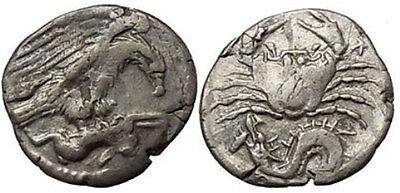
AKRAGAS in SICILY 420BC Hemidrachm Crab Hare Eagle Ketos Fish Silver Coin i40761
Greek city of Akragas in Sicily Silver Hemidrachm 15mm (1.84 grams) Struck circa 420-406 B.C. Reference: HGC 2, 105; SNG ANS 1010–3 Eagle standing right on hare; barley grain to left. Crab; below, ketos left with fish in its mouth.
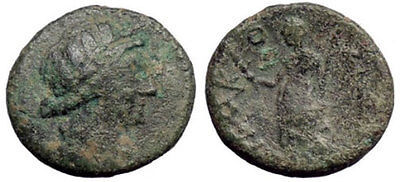
SICILY city AKRAI 210BC Underworld queen Demeter Cult Ancient Greek Coin i28403
Greek city of Akrai in Sicily Bronze 22mm (9.01 grams) After 210 B.C. Reference: Sear 1014; Calciati III pg. 37, 1; SNG ANS 902ff Wreathed head of Persephone right. AKPAIΩN, Demeter standing left, holding torch and sceptre.
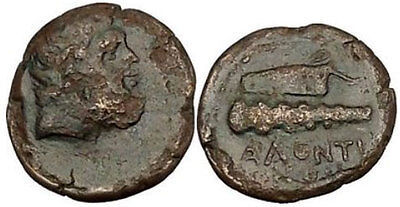
ALONTION in SICILY 400BC Hercules Club Quiver Ancient Greek Coin i41711
Greek city of Alontion in Sicily Bronze 15mm (2.63 grams) Struck circa 400 B.C. Reference: CNS 6; SNG ANS 1193 Bearded head of Hercules right. ΑΛΟΝΤΙNON, Club and quiver.
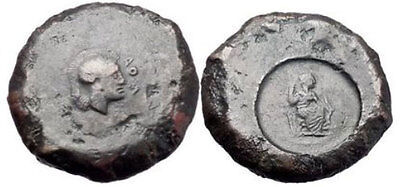
Athl / Atl / AΘA Mint in SICILY Rare 340BC Athena Rare Ancient Greek Coin i47252
Greek city or town Athl / Atl / AΘA Mint in Northwestern Sicily Bronze 30mm (26.95 grams) Struck circa 340-330 B.C. Reference HGC 2, 232; CNS III, p. 287, no. 1 AΘA, Head of Athena in Attic helmet right. Female figure enthroned right, holding palm branch or scepter and grounded bow; all within incuse circle.
Numismatic Note: This mint’s name has been previously misread as AΘΛ (Athl), in light of modern numismatic scholarship, AΘA is actually a Doric abbreviation for Athena. So therefore, the name of this mint is unknown. What is known is that the larger bronzes were re-struck on Syracusan issues from the period of 375-345 B.C.
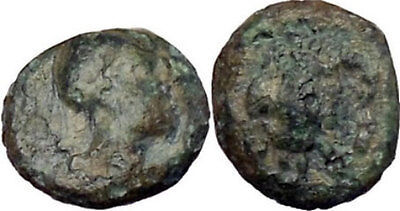
ERYX Sicily 400BC Female & Crab Rare Authentic Ancient Greek Coin i28255
Greek city of Eryx in Sicily Bronze 11mm (1.56 grams) Struck circa 400-330 B.C. Reference: Calciati I pg. 288, 28 var.; Gabrici pg. 131, 46-48 Female head right. Crab.
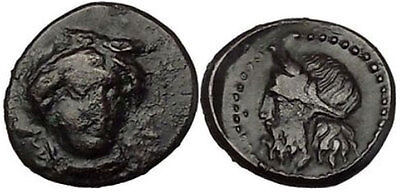
Gela in Sicily 339BC Rare Ancient Greek Coin Demeter River god Gelas i41739
Greek city of Gela in Sicily Bronze 15mm (2.90 grams) Struck circa 339-310 B.C. Reference: Sear 1099; Jenkins 549; B.M.C. 2.77-8 ΓΕΛΩΙΩΝ, Head of Demeter three-quarter face to right, wreathed with corn. Bearded head of river-god Gelas left, horned, and wreathed with horn.
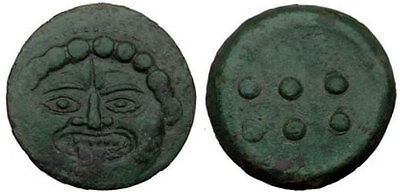
HIMERA Greek city in SICILY 420BC Hemilitron Large Ancient Coin Gorgon i37118
Greek city of Himera in Sicily Bronze Hemilitron 24mm (15.98 grams) Struck circa 450-420 B.C. Reference: Sear 1105; B.M.C. 2.,p.39,27-30 Gorgon’s head facing. Six pellets.
Numismatic Note: Fantastic coin in the most fantastic condition you can find, especially such a rarity!
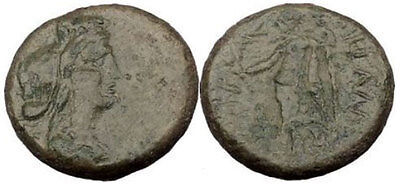
Hybla Megala in Sicily 210BC Hyblaia Modius Dionysus Panther Greek Coin i38058
Greek City of Hybla Megala in Sicily Bronze 19mm (7.30 grams) After 210 B.C. Reference: Sear 1115; Calciati III pg. 41, 1; SNG ANS 195ff Veiled head of Hyblaia right, wearing modius; behind, bee. ΥΒΛΑΣ ΜΕΓΑΛΑΣ, Dionysus standing left, holding kantharos and scepter, panther leaping up at feet.
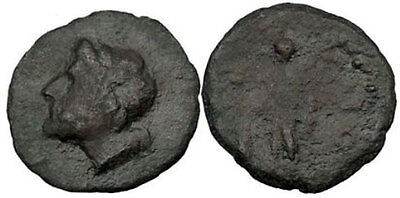
Iaitia in Sicily 241BC Zeus Hercules Authentic Ancient Greek Coin RARE i38057
Greek City of Iaitia in Sicily Bronze 17mm (2.26 grams) After 241 B.C. Reference: BMC – . SNG Cop. 333 var. SNG ANS – . SNG München – . Calciati I, S. 384, 6 Laureate head of Zeus left. IAITOY, Hercules
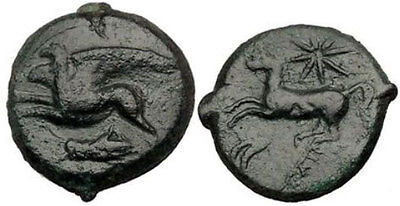
Alaisa “Kainon” in Sicily 360BC Rare Ancient Greek Coin Griffin Horse i43976
Greek city of Alaisa ” Kainon” in Sicily Bronze 23mm (8.72 grams) Struck 360-340 B.C. Reference: Calciati I pg. 252, 10; SNG ANS 1175ff Griffin running left; grasshopper below. Horse prancing left, reins loose; star above, KAINON in exergue.
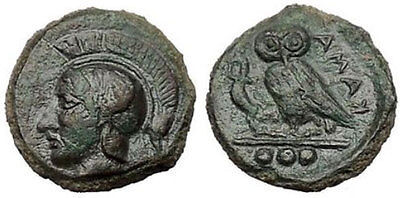
Kamarina in Sicily 413BC Authentic Ancient Greek Coin OWL Athena i46586
Greek city of Kamarina in Sicily Bronze Trias 15mm (3.36 grams) Struck 413-405 B.C. Reference: Sear 1063; B.M.C. 2.40 Head of Athena left, in crested helmet ornamented with wing. KAMA – Owl standing left, head facing, holding lizard in right claw; in exergue, three pellets.
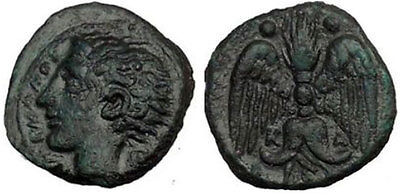
Katane in Sicily 413BC Ancient Greek Coin River god Winged thunderbolt i37312
Greek city of Katane in Sicily Bronze 12mm (1.93 grams) Struck 413-404 B.C. Reference: Sear 1067; Gabrici (La monetazione del bronzo nella Sicilia antica), pl. 2,7 AMENANOΣ, Horned head of young river-god Amenanos left. Winged thunderbolt dividing small K – A.
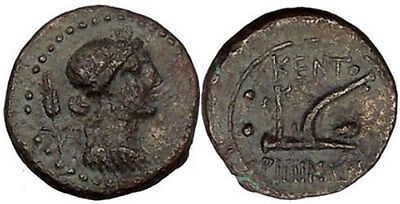
Kentoripai (Centuripae) in Sicily 211BC Ancient Greek Coin Demeter Plough i41811
Greek city of Kentoripai (Centuripae) in Sicily Bronze Hexas 17mm (3.95 grams) Struck 211-200 B.C. Reference: Sear 1084; B.M.C. 2.15; SNG Lloyd 928; Calciati 7; Campana 5 Bust of Demeter right, wreathed with corn; behind, tripod. KENTOPIПINΩN, Plough right, bird right on the share; two pellets in field to left.

Kephaloidion in Sicily 344BC Ancient Greek Coin Pegasus winged horse i36972
Greek city of Kephaloidion in Sicily Bronze 13mm (2.26 grams) Struck 344-336 B.C. Reference: Calciati pg. 371, 3; SNG ANS -. Head of Hercules right, wearing lion’s skin headdress. Pegasus flying right.
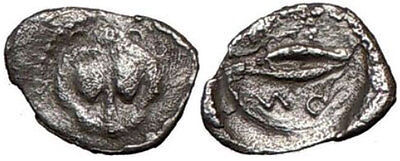
LEONTINOI in SICILY 475BC Lion Corn grain Ancient Silver Greek Coin i18500
Greek city of Leontinoi in Sicily Silver Obol 12mm (0.49 grams) Struck 475-466 B.C. Reference: Sear 828; B.M.C. 2.19 Lion’s head facing. ΛEON – Corn-grain.
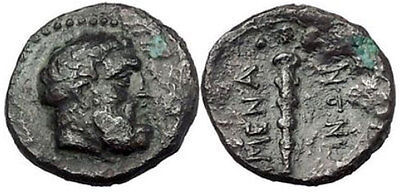
MENAINON in SICILY 2ndCenBC Hercules Club QUADRANS Ancient Greek Coin i46600
Greek city of Menainon in Sicily Bronze Quadrans 17mm (2.64 grams) Struck late 2nd Century B.C. Reference: HGC 2, 763; CNS III, pp. 188-189, nos. 12-12/6 Bearded head of Hercules right. MENAINΩN, club; mark of value, three pellets below.
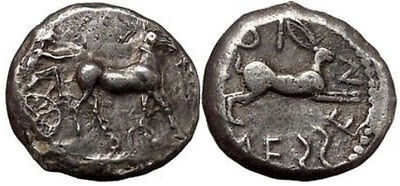
MESSANA in SICILY 480BC Tetradrachm Rare Silver Greek Coin Hare Chariot i40765
Greek city of Messana in Sicily Silver Tetradrachm 26mm (17.38 grams) Struck circa 480-461 B.C. Reference: SNG München 363 var.; Caccamo Caltabiani 218, 97 var.; Randazzo 59, 162 var. Charioteer driving biga of mules right; leaf in exergue. ΜΕSSΕ-N-ΙΟ-N, Hare springing right.
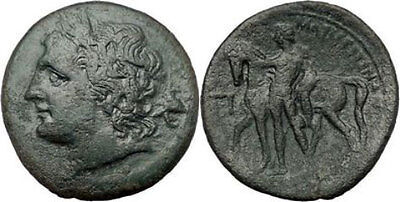
Messana in Sicily under Mamertini 220BC Greek Coin Ares Cult Dioskouros i46604
Greek city of Messana in Sicily under the name of Mamertini “Sons of Mars” Bronze Pentonkion 27mm (10.14 grams) Struck circa 220-200 Reference: Sear 1143; B.M.C. 2. 32 Laureate head of Ares left. MAMEPTINΩN – Horseman (Dioskouros) standing left, holding spear and touching the head of his horse standing left behind him; Π in field to left.
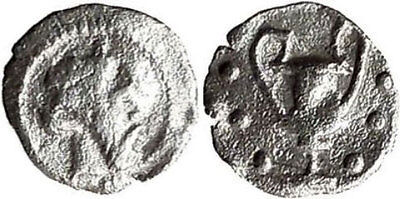
NAXOS in SICILY 461BC Silver Hexonkian Dionysus Kantharos Greek Coin i38811
Greek city of Naxos in Sicily Silver Hexonkion – Hemilitron 8mm (0.18 grams) Struck circa 461-430 B.C. Reference: Cahn 97 var. (V64/R– [unlisted rev. die]); Campana 12; Rizzo –; SNG ANS (Part 5) 1360 (same obv. die); SNG Lloyd –; SNG München –; Weber 618
Head of Dionysus right, wearing ivy wreath. Kantharos; six pellets around (mark of value).
Very rare.
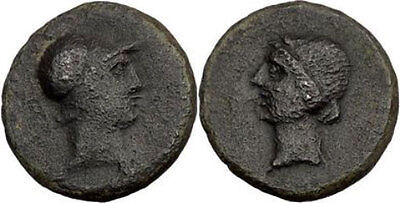
PANORMOS in SICILY 3rdCenBC Athena Persephone R1 Ancient Greek Coin i43658
Greek city of Panormos in Sicily Bronze 23mm (9.99 grams) Struck late third-early second centuries B.C. Reference: HGC 2, 1065 (R1); CNS I, pp. 331-332, nos. 12-12/6 ΠΑΝΟΡ/ΜΙΤΑΝ, Head of Athena in Corinthian helmet right. Head of Persephone left, werated with grain.
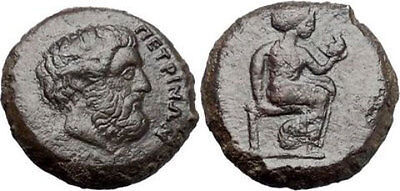
PETRA in SICILY 340BC Zeus Aphrodite RARE Authentic Ancient Greek Coin i47250
Greek city of Petra in Sicily Bronze 32mm (34.09 grams) struck circa 340-330 B.C. Reference: HGC 2, 1097 (R2); CNS III, p.317, no. 1 ΠΕΤΡΙΝΩΝ, Head of bearded Zeus right. Aphrodite enthroned right, holding dove.
Not much is known about the settlement, although it could be believed it was fortified as it’s name translates to “the Rock”. Numismatic evidence locates the city to have been located in the area of northwestern Sicily, and that it was founded before circa 350 B.C. The city gave itself over to Roman control in 254 B.C. during the First Punic War. The community survived until the second century A.D.
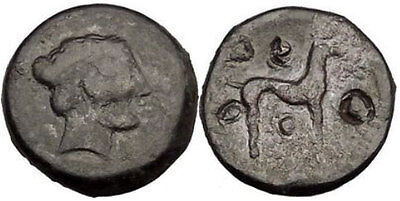
SEGESTA in SICILY 410BC Hound Dog Authentic Ancient Greek Coin i43985
Greek city of Segesta in Sicily Bronze Triantes 19mm (7.95 grams) Struck 410-400 B.C. Reference: HGC 2, 1181 Head of Aigiste right, wearing sphendone. Hound standing right, four round punched value marks around.
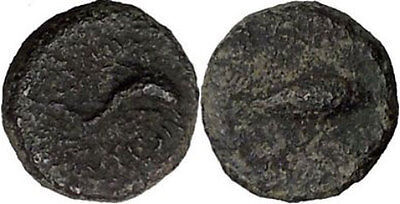
Solus in Sicily 2ndCenBC Dolphin Tuna Fish Authentic Ancient Greek Coin i43653
Greek city of Solus in Sicily Bronze 12mm (2.17 grams) Struck late second-early first centuries B.C. Reference: HGC 2, 1269 (R3); CNS I, p. 312, no. 17 COΛΟΝ/ΤΙΝWΝ, dolphin leaping right. Tuna swimming right.

Syracuse in Sicily 344BC Timoleon Ancient Greek Coin Athena Dolphins i46625
Greek city of Syracuse in Sicily Time of Timoleon Bronze Litra 30mm (31.71 grams) Struck 344-336 B.C. Reference: Sear 1189; B.M.C. 2. 287 ΣΥΡΑ, Head of Athena left, wearing Corinthian helmet bound with olive-wreath. Starfish between two dolphins.
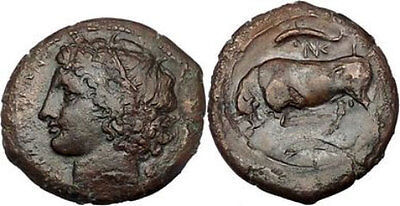
Syracuse in Sicily AGATHOKLES 317BC Persephone Bull Dolphins Greek Coin i46589
Greek city of Syracuse in Sicily Agathokles ( Agathocles)- Tyrant of Syracuse 317-289, King of Sicily 304-289 B.C. Bronze 23mm (9.04 grams) Struck circa 317-310 B.C. Reference: HGC 2, 1444 ΣYPAKOΣIΩN, Head of Persephone left, wreathed with grain; symbol behind. Bull charging left; dolphin above and below; NK monogram above.
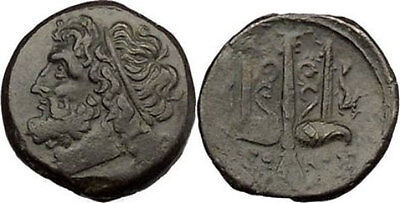
Syracuse Sicily 270BC King Hieron II Ancient Greek Coin Poseidon Trident i39151
Greek city of Syracuse in Sicily Bronze 20mm (7.13 grams) under king Hieron II, 270-215 B.C. Reference: Sear 1223; B.M.C. 2. 603 Head of Poseidon left, wearing tainia. Ornamented trident-head, between two dolphins, dividing IEPΩ – NOΣ.
0 notes
Text
Thugga (también Dougga) era una ciudad en el norte de África que primero fue un asentamiento númida y luego un cartaginés antes de ser incorporado al Imperio Romano. La ciudad fue construida sobre una colina de piedra caliza estratégicamente favorable con vistas al fértil valle de Wadi Khaled (Túnez moderna) y particularmente floreció durante los siglos II y III ac.
Thugga se estableció por primera vez en la Edad del Bronce, si no antes. Aparece por primera vez en el registro histórico más amplio cuando fue conquistado por Agathocles de Siracusa en el siglo IV a. Luego, se convirtió en una importante ciudad númida desde el reinado de Masinissa (238-148 a. C.) cuando Numidia era un aliado de la cercana Cartago, 130 km al noreste. Se construyó un templo dedicado al rey númida y también de este período sobrevive un mausoleo de un noble númida. Lleva inscripciones en Numidian y Púnico, que ilustran los lazos cercanos entre las dos culturas. De hecho, Thugga estaba ubicado casi en la misma frontera, la fossa regia, entre las esferas de influencia cartaginesas y numidianas. La prosperidad de la ciudad en este período se atestigua aún más por los hallazgos de las tumbas de joyas, vasijas de vidrio y cerámica de lugares tan lejanos como Grecia e Italia, que incluso incluyen ánforas de vino de Rodas.
Cuando Roma derrotó a Cartago, una afluencia de colonos marianos llegó a Thugga (según algunos historiadores, pero no todos estuvieron de acuerdo). La influencia romana aumentó aún más después de la Batalla de Thapsus en 46 de. Partes del territorio de la ciudad estaban controladas por las colonias de Cartago, lo que condujo a una compleja administración dual aún debatida por los estudiosos. Los residentes nativos y númidas ( civitas ) eran gobernados por los suffetes locales (administradores judiciales púnicos) mientras que el populacho romano ( pagus ) miraba a Cartago por su gobierno. El sistema no se simplificó hasta que el emperador romano Septimius Severus unificó la administración e hizo Thugga un municipium en 205 DE. Luego, en 261 DE, Thugga se convirtió en una colonia en sí misma. Desde el siglo III DC., Thugga envió obispos a los concilios celebrados en Cartago, pero la ciudad llamativamente carece de los grandes edificios cristianos vistos en otras ciudades de la región.
En el período bizantino, la ciudad fue fortificada alrededor del foro y se construyó un pequeño fuerte. Aunque nunca fue totalmente abandonado, tal fue el estado disminuido de la ciudad desde la Antigüedad tardía que nunca hubo una necesidad de reutilizar los materiales de construcción de las ciudades con monumentos más antiguos. Como consecuencia, han sobrevivido notablemente bien y se han ganado el sitio como Patrimonio de la Humanidad por la UNESCO.
La ciudad se encuentra pleno campo y todavía está alejada del crecimiento urbano, contrariamente a Cartago que fue multitud de veces reconstruido a lo largo del tiempo. Este lugar es notable por su tamaño 70 hectáreas, la buena conservación de sus monumentos y la diversidad de las civilizaciones que la ocuparon, la púnica, la númida, la romana y la bizantina.
Los monumentos más importantes de Dougga :
Mausoleo líbico-bereber – Se trata de uno de los pocos ejemplos de arquitectura real númida. Esta tumba de 21 metros de altura edificada en el siglo II a. C. está dedicada a Atban (hijo de Iepmatath y de Palu). Sobre la cara norte del primero de los tres pisos, una ventana cerrada por una baldosa se abre a la cámara funeraria. Las otras caras están decoradas por falsas ventanas.
Templo de Saturno – El templo de Saturno es el heredero de Baal Hammón púnico y consorte de Tanit / Caelestis. Los restos del templo (poco importantes al lado de los del Capitolio y del templo de Juno Caelestis) son particularmente interesantes por su ubicación, las ruinas que se levantan sobre un promontorio con vistas sobre un feraz valle cerealista.
Arco de Alejandro Severo – El Arco de Alejandro Severo, consiste actualmente en los restos de una estructura que formaban un arco triunfal dedicado al emperador romano Alejandro Severo. Fue construido en el siglo III, hacia el 230. El arco de cuatro metros de abertura, está sostenido por dos pies decorados con hornacinas rectangulares poco profundas, aún se conserva en buen estado pero la parte superior se encuentra deteriorada. Estuvo realizado como agradecimiento al emperador por los privilegios concedidos a la ciudad.
Arco de Septimio Severo de Dougga – El Arco de Septimio Severo de Dougga lo conforma actualmente los restos de una estructura que formaban un arco triunfal que estaba dedicado al emperador Septimio Severo (193-211) en conmemoración de la elevación de la ciudad a municipio. Fue construido a principios del siglo III. Está formado por un arco de cinco metros de abertura sostenido por pies decorados con hornacinas rectangulares poco profundas. Tiene una inscripción dedicada al emperador y a su esposa Julia Domna y otra a los hijos Caracalla y Publio Septimio Geta.
Capitolio de Dougga – El Capitolio de Dougga es un templo romano que fue construido en el siglo II y estaba dedicado a los dioses protectores romanos, Júpiter, Juno y Minerva. El templo está precedido por una plataforma enlosada que servía para los fieles; tiene una escalera que da a un pórtico con cuatro columnas, con capiteles de orden corintio, en la fachada y dos más en ambos lados, después de las cuales se encuentra una sala de culto de 13 x 14 metros, con tres nichos en el fondo donde se encontraban las esculturas de Júpiter en el centro y a sus lados la de Juno y Minerva. En el frontón había un relieve escultórico, que representaba un hombre con un águila, simbolizando la apoteosis del emperador Antonino Pío (138-161).
Casa de Górgona – Conserva mosaicos en el pavimento. Está ligeramente separada del resto de casas, al sureste de la villa, con la entrada principal señalada por un porche, su subsuelo cogía la luz de la calle por claraboyas; se entraba por una puerta de la parte sudeste. En el vestíbulo se encontraba una cisterna con las bóvedas sostenidas por dos filas de tres pilares. Debe su nombre al mosaico del vestíbulo que figura en un medallón central que muestra la cabeza de Medusa, y que está el Museo del Bardo aunque su estado no es muy óptimo.
Cisternas de Dougga – Las cisternas de Dougga son un grupo de cisternas, cada una tenía un acueducto que garantizaba el suministramiento del agua. Las cisternas no tenían nombre (o no se conoce) y son llamadas por el nombre moderno de las fuentes que las abastecían: Aïn El Hammam y Aïn Mizeb. El acueducto de la cisterna de Aïn Hammam fue construido durante el reinado de Cómodo y tenía doce kilómetros de longitud entre la fuente, al oeste, y la cisterna; la cisterna tenía una capacidad de 6.000 m3 y estaba formada por cinco depósitos de una medida de 34 x 5 metros cada uno (además de una cisterna perpendicular de decantanción). En este lugar celebraban los habitantes la fiesta de su patrona la Mokhôla, donde se hacía sacrificos de animales. El acueducto está bien conservado y fue dedicado al emperador por el notable de la Civitas Aurelia Thugga que lo pagó, siendo proconsul Marcus Antonius Zeno (184-187) y fue restaurado en el 376 según una inscripción; nace entre el Djebel Fej El Hdoum y el Djebel Bou Khoubaza, al sudoeste de Dougga sobre unos 8.500 metros en línea recta, tiene un cuadro de captación de 10x 10 metros cerca de la fuente de Aïn El Hammam, la mayor parte de su recorrido es subterráneo hasta llegar a la cisterna. La cisterna de Aïn Mizeb tiene capacidad para 9.000 m3, con siete depósitos, se construyó en dos fases. Están formadas por depósitos de 35 x 5 metros cada uno más un octavo depósito perpendicular de decantación. La fuente de Aïn Mizen estaba a 200 metros al noroeste y el acueducto era subteráneo con una altura de 160 cm y 50 cm de ancho.3 La fuente aún está en servicio.
Foro de Dougga – El Foro de Dougga es una plaza pavimentada, con algunos restos en su contorno, que se encuentra en la parte izquierda mirando al capitolio de frente. Está protegido en el fondo por una muralla bizantina de construcción muy posterior. El fórum medía 38,5 x 24 metros y estaba rodeado de pórticos por tres de sus lados.
Necrópolis dolmética de Dougga – La necrópolis dolmética es un cementerio númida. Está formada por tumbas de tipo dolmético, con bóveda, y de balsa circular. Las tumbas dolméticas son una especie de caja abierta por un lado y formada por tres losas colocadas planas sobre las que reposa una losa de cobertura casi siempre de gran tamaño; generalmente son tumbas colectivas y gracias al lado abierto se podía reutilizar, este lado abierto se cerraba después del enterramiento con un muro de piedras fácilmente desmontable. Se han encontrado esqueletos humanos y restos de cerámica. Están datadas a partir del segundo milenio antes de Cristo, aunque seguían en uso durante el siglo I. Hay un tipo de tumba, las de bóveda y de balsa, que inicialmente se identificaron como dos torres de la muralla númida y que son en realidad dos tumbas de bóveda rectangulares, de tumbas de balsa sólo se ha encontrado una, de forma circular con unas losas laterales en el centro y cubiertas por una losa monolítica encima, el monumento se le considera una tumba por el contexto en el que se encontró, junto a otras tumbas.
Teatro romano de Dougga – El teatro romano de Dougga se encuentra en el yacimiento arqueológico de Dougga en Túnez, fue construido entre el 168 y 168 y es de los mejores conservados en el África romana, podía acoger a 3.500 espectadores, cuando la ciudad contaba con unos 10.000 habitantes, en su periodo de mayor esplendor. Fue construido a costa de Publio Marcius Quadratus. Se compone de una cavea (19 gradas en tres plantas divididas por pasos de circulación), una orquesta y un escenario. Actualmente se hace servir aun como teatro y se representan algunas piezas clásicas, durante el festival de Dougga. Un teatro más pequeño conocido como «Teatro del culto», era donde se desarrollaban las ceremonias dedicadas al culto de Liber Pater, se encuentra cerca de los templos de Concordia, Frigifer y Liber Pater. Tiene acceso por una puerta en el muro al complejo de los Templos menores de Dougga y antiguamente, por una escalera que ya no existe, se bajada a una galería de la parte superior de la cavea. No tenía escenario pero si orquesta con una forma de un segmento de círculo. Debajo se han encontrado restos de edificaciones númidas.
Templo de Juno Caelestis – El Templo de Juno Caelestis es un templo dedicado a Juno Caelestis que antes estuvo dedicado a la diosa púnica Tanit. El templo se encuentra bastante bien conservado con numerosas columnas; su forma era rectangular en su parte frontal y semicircular en la parte trasera; el acceso lo tenía por la parte de la derecha y daba a un patio, una escalera con once escalones que se conservan conducen hacia el santuario, en la parte frontal había dos cámaras subterráneas. El conjunto estaba limitado por muros. Se encuentra situado en el centro de una necrópolis dolmética y no lejos del arco de Alejandro Severo, en el reinado del cual se contruyó (222-235), bajo el auspicio de Gabinius Rufus Felix, que hizo depositar dos estatuas en plata de la diosa con un coste de 35.000 sestercios. Su forma es excepcional dentro de la arquitectura religiosa de la antigua África romana.
Templo de Masinisa – Su nombre original es maqdes (santuario) de Masinisa y fue edificado en memoria de este rey muerto en el 148 a. C. Este templo se encuentra en el oeste del Capitolio de Dougga, cerca del foro y está construido por unos bloques de piedra que forman una estructura rectangular de 14,65 metros de largo y 6,30 de ancho, similar al santuario de Simithus construido igualmente durante el reinado de Micipsa (148-118 a. C.) Antes de su identificación ya era conocido por una inscripción bilingüe púnica y líbica, encontrada en 1904 cerca del foro y hoy conservada en el Museo nacional del Bardo. Está datada el 139 a. C. y en ella se conmemora la construcción por los notables de la ciudad de Thugga (Dougga), del maqdes en memoria del rey Masinisa.
Templo de Minerva de Dougga – es un templo pagano construido por los romanos en la segunda mitad del siglo I bajo el mandado del emperador Domiciano o bajo Antonino Pío (138-168). Lo costeó la sacerdotisa del culto imperial Iulia Paula Laenatiana. Su estado es muy precario con sólo una pequeña parte de las paredes aún en pie y algunas columnas además del pavimento. Se encuentra orientado al sudoeste. La sala principal estaba precedida por un pórtico ya desaparecido; a la sala de culto se accedía por una escalera monumental erigida sobre un podio y al interior de la sala había otras salas que tenían acceso por puertas laterales.
Templo de Plutón – Situado cerca de las termas de los Cíclopes, dedicada a templo pagano, y que se supone que podía estar dedicado al dios Plutón ya que un busto de Plutón se encontró durante la excavación del yacimiento (Plutón era el genio protector de Thugga (Dougga)). Se conserva el pavimento, la escalera, una puerta y algunas columnas.
Termas de Aïn Doura – Son unas fuentes de piedra bastante bien conservadas. Eran probablemente las principales termas de la ciudad aunque no las únicas. Su nombre clásico no se conoce y se le da el nombre que tenía la fuente descubierta a finales del siglo XIX y que le daban los habitantes de la ciudad de Dougga. Aïn Doura es el nombre dado a un complejo formado por la fuente, unas termas, unas letrinas y unas cisternas. El establecimiento termal tiene forma de T y está en terreno pendiente, una vez excav ado el lugar se han identificado el frigidarium o sala de baños fríos con cuatro piscinas, el tepidarium para la salida del baño, tres salas calientes y algunas salas de servicios. Las letrinas están en el sudoeste y son semicirculares con 2,70 metros de diámetro; los asientos han desaparecido. Cerca del edificio se encuentran tres cisternas separadas por arcadas de 28,5 x 25 metros y capacidad de tres mil metros cúbicos.
Termas de Caracalla – Son un establecimiento termal romano en el suroeste del foro. Fue construido en el reinado de Caracalla (212-217) y por su tamaño es considerado uno de los más importantes establecimientos termales romanos del Magreb. Tiene acceso por una puerta que da al atrio y de allí una gran escalera de 24 escalones conduce a una sala de entrada, de la que se pasaba a las diferentes salas de las termas: los vestíbulos, el apodyterium (vestuario ), el frigidarium (baños fríos), el elaeothesium (sala de masajes y de aceite), la palestra (sala de cultura física), el sudatorium (especie de sauna), el laconicum (sala seca), los caldara (sala de baños calientes, de las cuales había tres) y el tepidarium (sala de baños templados). Debajo de las salas calientes había un sótano de servicio.
Termas de los Cíclopes – son unas termas romanas que fueron construidas probablemente a comienzos del siglo III, de la que la parte de las letrinas (utilizadas ya en el siglo II) está en bastante buen estado. Deben su nombre al mosaico de los baños que representaba unos cíclopes (hoy en el Museo nacional del Bardo), mosaico que estaba en el frigidarium (sala de baños fríos). Se trata de unos edificios del que sólo quedan partes de las paredes, algunas columnas, y piedras fuera de lugar; el acceso a los baños es por una puerta que da a la calle, tiene una sala que se prolonga al este por una piscina rectangular que termina en un hexaedro. El tamaño del edificio es de unos 30 m2, lo que ha llegado a pensar que podía tratarse de un lugar privado. En el interior del edificio de letrinas (edificio mucho más pequeño), con doce asientos de letrina para uso público y con una fuente para lavarse en la entrada. Las aguas y excrementos iban a unas conducciones y acababan en una cisterna que una vez llena se vaciaba para utilizar el contenido como abono.
Trifolium de Dougga – es un edificio que estaba dedicado a prostíbulo. En una piedra de los alrededores, un pene grabado sobre la piedra y dos pechos, marcan el camino. Junto al trifolium estaban los baños (letrinas), los cuales están relativamente bien conservados. El Trifolium está en el barrio del sur y es la casa particular más grande del lugar de Dougga. Está formado por una planta a ras de calle (de la que casi no queda nada) y una a nivel inferior aprovechando el desnivel. El acceso era por un porche con dos columnas en la calle, y se entraba a un vestíbulo del que salían las escaleras que bajaban a la planta inferior, organizada en torno a un patio rodeado de un pórtico y ocupado el centro por un jardín. En la galería oeste estaban las tres puertas de la gran cámara, el oecus, que también daba al norte a otra cámara, en la parte sur las habitaciones eran más pequeñas; en la zona del pórtico había una cisterna y a su lado una fuentecilla.
Templos menores de Dougga
Los templos menores de Dougga son una serie de templos paganos del yacimiento arqueológico de Dougga en Túnez, que fueron construidos en el siglo I y en el siglo II. El templo de Mercurio y el de Augusto están a la derecha del Capitolio de Dougga, los templos de la Concordia, de Liber Pater y Frugífera y el templo de Tellus se encuentran frente al capitolio más próximos al mercado de Dougga. Los restos están relativamente bien conservados y constituyen sólo una pequeña parte de los templos de la ciudad, ya que se han constatado por inscripciones encontradas, la ubicación de 28 templos durante el siglo III, y sólo hay 19 localizados.
El templo de Augusto o de la Fortuna de Augusto, el de la Concordia de Venus y el de Mercurio Augusto fueron construidos en el reinado del emperador Adriano. Estos templos los pagó el patrón de la civitas y del pagus Quintus Maedius Severus en su nombre y de su hija la flaminicae perpetua, Maedia Lentula.
El templo de la Piedad de Augusto se construyó en ejecución del testamento de Cayo Pompeu Nahanius, en un terreno de su propiedad, tiene escalera de acceso con siete escalones y un vestíbulo con un pequeño ábside elevados sobre un podio, éste es relativamente bajo (1 metro a 1,5 metros). Fue identificado en 1631 por Thomas Arcos, por medio de una inscripción que sigue vigente en este momento.
El templo de Mercurio al lado del Capitolio es del reinado de Cómodo (180-193) y lo costeó Quintus Pacuvius Saturus y su esposa Nahania Victoria ejecutando el testamento de su hijo, un militar muerto en servicio. En este templo, que poseía tres salas de culto (una rectangular en medio y dos semicirculares a los lados) se encontraron unos sarcófagos del período del Bajo Imperio, y una prensa de aceite del tiempo de los vándalos.
El templo de Tellus estaba dedicado a esta diosa y fue edificado en un terreno privado a finales del siglo I, y restaurado el 261 a costa de la flaminicae perpetúa Botria Fortunata. Es de reducidas dimensiones y tiene una escalera de acceso con tres escalones, está rodeada por un peristilo y tiene tres celdas con tres nichos semicirculares.
Dentro de este grupo hay que incluir en el templo de Neptuno, un pequeño santuario, con nombre provisional ya que no se sabe a quién estaba dedicado aunque Neptuno es la deidad más probable, se encuentra cercano al templo de Saturno y orientado al este dominando el valle del Oued Khalled. Tiene unas escaleras que dan a un pórtico y de allí se entra a la sala de culto; tenía un nicho donde estaba la deidad tutelar.
El templo de Liber Pater o Patria y a Fruguífera se construyó sobre un terreno de propiedad de Aulo Gabinio Dat y a sus costa y de su hijo Marco Gabinio Bas. Junto con el templo de Concordia construido por ellos mismos, es conocido como templos o complejo de los Gabin (Gabinii).
El templo del Sol es un pequeño santuario de planta cuadrada, en el antiguo camino entre la cisterna de Aïn Mizeb y el templo de Minerva. Se construyó a finales del siglo III y se accede por cuatro escalones que dan a un vestíbulo donde se entra a la sala de culto.
Otros templos menores son: una capilla pagana del siglo I, el santuario de Minerva (diferente del Templo de Minerva), un templo anónimo construido en la segunda mitad del siglo II, otro templo anónimo al norte del templo de Mercurio, y otro templo anónimo al norte del santuario líbico-púnico.
Finalmente, hay villas privadas y viviendas, muchas de las cuales tienen pisos de mosaico bien conservados, y el fuerte bizantino construido en el sitio del foro romano. Algunas partes de las fortificaciones de la ciudad construidas para protegerse de los ataques vándalos también sobreviven. Además de edificios, Dougga ofrece varias estelas grandes de la época púnica tardía. Las primeras datan del siglo III a. EC y aún llevan motivos fenicios como discos alados, mientras que las últimas, del siglo I aC, muestran una evolución en el uso del símbolo Tanit y una influencia cultural púnica continua.
Viajes a Tunez – Dougga un paseo en el corazón de la historia Thugga (también Dougga) era una ciudad en el norte de África que primero fue un asentamiento númida y luego un cartaginés antes de ser incorporado al Imperio Romano.
#Arco de Alejandro Severo#Arco de Septimio Severo de Dougga#Capitolio#Capitolio de Dougga#Casa de Górgona#Cisternas de Dougga#dougga tunez#Foro de Dougga#Mausoleo líbico-bereber#Necrópolis dolmética de Dougga#Teatro#teatro de dougga#Teatro romano de Dougga#Templo de Juno Caelestis#Templo de Masinisa#Templo de Minerva de Dougga#Templo de Plutón#Templo de Saturno#Termas de Aïn Doura#Termas de Caracalla#Termas de los Cíclopes#Trifolium de Dougga
0 notes
Photo
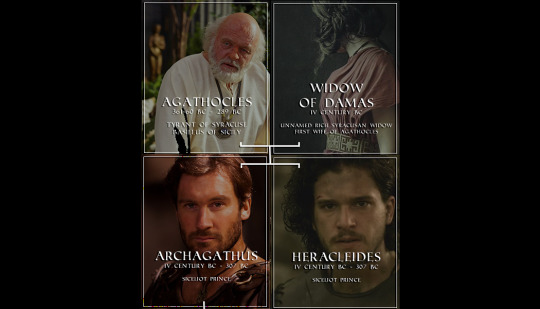

The Syracusan descendants of Agathocles of Syracuse and his first wife, the Widow of Damas
ARCHAGATHUS (Ἀρχάγαθος) was a Syracusan Greek prince, son of tyrant Agathocles by his first wife, the Widow of Damas. He shared his name with his younger half-brother, Archagathus of Lybia. In 310 BC he joined his father’s African expedition. After being defeated by the Carthaginians in the Battle of Himera and being besieged in Syracuse, Agathocles feared for his rulership. As his dominance over the other Sicilian cities was based on Syracuse’s military supremacy, the tyrant knew he had to stop Carthage, possibly on its own soil. While in Africa, Archagathus was publicly accused during a banquet by a man named Lyciscus (at that moment quite drunk) to have committed incest with his step-mother, Alkeia. Affronted by the accuse, Archagathus mortally wounded the man, shocking the bystanders. The murder almost cost the prince’s life as Lyciscus’ friends together with many other outraged soldiers asked Agathocles to hand them over his son so that he may be put to death. If the tyrant refused, then he had to die instead of Archagathus. Since he knew the Carthaginians were actively trying to have his men change side, and fearing he might end up being handed over to his enemy, Agathocles judged it was preferable risking his life amid his people. He then put aside his regal clothes and stood unprotected in the middle of the crowd. After giving a passionate speech, he motioned as if he was going to kill himself with his sword. The crowd stopped him and urged him to put on his royal garbs once more. Moved and thankful, Agathocles obliged while being acclaimed by the people. He had managed thus to protect his own as well his son’s life, strengthened his position and won a symbolic victory over the Carthaginians. In 307 BC, Agathocles had to go back to Sicily to stop the Siceliot city of Akrágas to challenge Syracuse’s power. Archagathus, as the tyrant’s eldest son, was left in charge of the African expedition. After a series of military victories, the army led by Archagathus was defeated thrice and was forced to seek refuge in Tunis. Knowing that his son was struggling, Agathocles returned to Africa to help him. The tyrant found a decimated and disgruntled army, on the verge of mutiny. Unfortunately for Agathocles, his attempt to rile up his men met with a bitter loss which cost the life of 300 soldiers, the execution of 3000 prisoners at the hands of the Carthaginians, and the mutiny of 10000 allied soldiers. Sensing the army’s hostility, the tyrant chose to hastily abandon Africa, leaving his sons behind. Without his father’s backup, Archagathus together with his brother Heracleides became an easy target for the angry soldiers, who ordered they had to be put to death. The murder of his children angered Agathocles to the point he ordered the massacre of all the relatives of those Syracusan soldiers who were part of the African expedition. Children, women and old people, nobody was spared, making this the most tragic slaughter ordered by Agathocles.
HERACLEIDES (Ἢρακλείδης) was a Syracusan Greek prince, son of tyrant Agathocles by his first wife, the Widow of Damas. According to Greek author Polyenus, Heracleides’ good-looking was instrumental in his father’s plot to eliminate Macedonian former hetairos (Alexander’s companions), Ophellas, at that time Ptolemaic governor of Cyrenaica. Once allied, Agathocles grew quickly disaffected with the Macedonian, to the point of planning to get rid of him. Knowing that Ophellas liked pretty boys, Agathocles offered him his son Heracleides as a hostage to prove his goodwill and desire to form an anti-Carthaginian alliance with the Macedonian warrior. Heracleides’ received secret instruction from his father to entice Ophellas, but in the meantime to resist the older man’s overtures. The plan succeeded as Ophellas fell madly in love with that beautiful boy, and tried his best to convince Heracleides to give himself to him. While he was in his tent courting the boy, Agathocles barged in. Feigning shock and disgust, Agathocles accused his former ally to have betrayed him, trying to seduce his son. Caught off guard, Ophellas didn’t even had the chance to defend himself before Agathocles killed him. The wronged father then took his son back to the Syracusan camp. Without a leader, the Cyrenaic troops were incorporated by Agathocles’. Heracleides took part in the disastrous African expedition together with his brother and father, sharing Archagathus’ tragic end at the hands of the Syracusan soldiers.
ARCHAGATHUS (Ἀρχάγαθος) was a Syracusan Greek prince, son of Archagathus (firstborn of Agathocles) by an unknown woman. Described as a young man with great virility and strength, on account of these qualities, after his father’s death in Lybia, he must have thought he was to be his grandfather’s heir. Unfortunately for him, Agathocles had already decided to have his namesake son, Agathocles II, succeeding him. Seeing as his dreams of power were about to be shattered, Archagathus planned to kill both his grandfather and half-uncle and secure by himself his succession. He dragged in the murderous plan a certain Menon, a Segesta-born slave, who was ordered to put poison on the quill the older Agathocles used to clean his teeth after eating. As for the younger Agathocles, he was lured by his half-nephew on an island. There, Archagathus had the unsuspecting uncle getting drunk, then he killed him. Agathocles junior’s body was then thrown into the sea (perhaps hoping it would disappear forever), being later washed ashore by the waves, where some people recognized him. In the meantime, the agonizing tyrant (the poison didn’t kill immediately, but caused him a slow death), now aware of his grandson’s terrible scheming, publically denounced Archagathus, asking the Syracusan to avenge his death and, in exchange, granting them the freedom. He declared the tyranny decayed and announced Syracuse was once again a democracy. As for Archagathus, he fled away from Syracuse together Menon, who later killed him, smug with the idea of having been the one who had successfully overthrown Agathocles’ despised tyranny.
see here the Egyptian descendants of Agathocles
see here the Epirote descendants of Agathocles
#history#greek history#ancient history#sicily#Agathocles of Syracuse#house of agathocles#archagathus (son of agathocles)#archagathus (son of archagathus)#agathocles ii#heracleides (son of agathocles)#siracusa#greek sicily#ophellas#menon of segesta#province of siracusa#myedit#people of sicily#historyedit
3 notes
·
View notes
Photo



The House of Hiero II of Syracuse (IV-III century BC)
check here for the Women of the House of Hiero II of Syracuse
check here for the related Epirote branch of the House of Agathocles of Syracuse (III century BC)
#history#women#historical women#historicwomendaily#greek history#hiero ii of syracuse#gelo (son of hiero II)#Demarata#heraclia#Harmonia#hieronymus of syracuse#House of Dionysius#house of agathocles#Greek Sicily#siracusa#province of siracusa#myedit#historyedit#people of sicily#women of sicily
16 notes
·
View notes
Photo
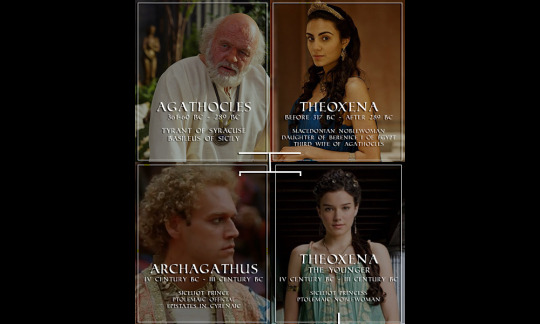
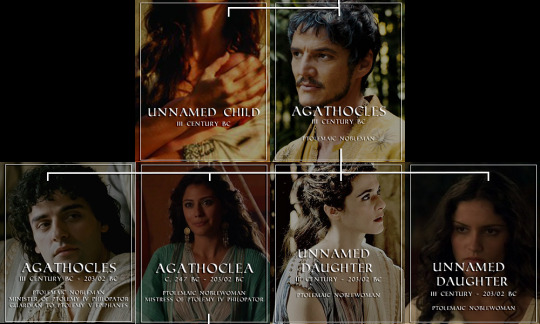

The Egyptian descendants of Agathocles of Syracuse and his third wife Theoxena
ARCHAGATHUS OF LYBIA (Άρχάγαθος) son Agathocles by his third wife Theoxena, a Greek Macedonian noble. When only a child, he was forced to leave Syracuse with his mother and sister Theoxena the Younger. They found refuge in Egypt, at the court of his maternal grandmother Berenice I and his step-grandfather Ptolemy I. Given his family background, Archagathus was a man of high status. He served as an epistates under Ptolemy I, Ptolemy II (who was Archagathos’ half-uncle) and possibly even under Magas (his full blooded maternal uncle) when he served as Ptolemaic Governor and later became King of Cyrene. At some point, he married a noblewoman named Stratonice. Together with his wife, Archagathus made a dedication of a temenos to Isis and Serapis at Alexandria on behalf of his uncle Ptolemy II and his grandmother Berenice. No mention is made anywhere about any children fathered by Archagathus.
THEOXENA THE YOUNGER see
AGATHOCLES (Ἀγαθοκλῆς) son of Theoxena the Younger and her unnamed husband. Agathocles, born and raised in Egypt, was named after his maternal Sicilian grandfather, Agathocles tyrant of Syracuse. Despite being closely related to the Ptolemaic royal family, very little is known about him. He married an Egyptian Greek noblewoman called Oenanthe, who bore him four children: Agathocles, Agathoclea and two unnamed daughters. After his death, his widow remarried to Theogenes (also known as Theognetos or Diognetos), a prominent Egyptian Greek.
AGATHOCLES (Ἀγαθοκλῆς) son of Agathocles (son of Theoxena the Younger) and his wife Oenanthe. Thanks to his mother’s meddling, he was introduced to Ptolemy IV (his father Agathocles’ half-second cousin) and took advangate of his own sister’s affair with the Pharaoh to increase his influence over the court. In 216/215 BC Agathocles served as eponymous priest of the Ptolemaic cult of Alexander the Great. When Ptolemy died in 205 BC, Agathocles, his sister Agathoclea and their party tried to kept the event secret to get the chance to plunder the royal treasure without any interference. When the plan to name Agathocles the new Pharaoh failed, together with Sosibius (chief minister of the late Ptolemy IV), his sister plotted to make the same Agathocles the regent for the new young King Ptolemy V. To achieve this, the Queen mother Arsinoe was murdered. When Ptolemy and Arsinoe’s death were made public, Sosibius presented the young Ptolemy V and crowned him as the new King. Sosibius later read out Ptolemy IV's will (Polybius thought that it was a forgery produced by Sosibius and Agathocles themselves), which made Sosibius and Agathocles regents and placed Ptolemy V in the personal care of Agathoclea and her mother Oenanthe. At some point Agathocles may have killed his former ally Sisibius, although all particulars of these events are lost to us. Soon the Egyptians and Greeks of Alexandria grew exasperated at Agathocles' outrages and in 203/202 BC rose against him. They surrounded the palace in the night, and forced their way in. Agathocles was killed by his friends, who wanted to spare him a more cruel ending.
AGATHOCLEA (Ἀγαθόλεια), daughter of Agathocles (son of Theoxena the Younger) and his wife Oenanthe. Like her brother, thanks to her mother’s meddling, she was introduced to Ptolemy IV and quickly became his mistress. Agathoclea’s influence over the Pharaoh didn’t diminish even after he married his sister Arsinoe in 220 BC. In late 210 BC, Agathoclea may have bore Ptolemy IV a son, who have died shortly after his birth. When Ptolemy died in 205 BC, Agathoclea and her party tried to kept the event secret to get the chance to plunder the royal treasure without any interference. When the plan to name her brother the new Pharaoh failed, together with Sosibius (chief minister of the late Ptolemy IV), she plotted to make Agathocles the regent for the new young King Ptolemy V. To achieve this, the Queen mother Arsinoe was murdered. Ptolemy IV's (likely forged) will placed Ptolemy V in the personal care of Agathoclea and her mother Oenanthe. In 203/202 BC the Egyptians and Greeks of Alexandria rose against Agathocles and his party. They surrounded the palace in the night, and forced their way in. Agathoclea, with her sisters and mother, had taken refuge in a temple. With no regard of the sacredness of the place, they were dragged out by the angry mob, stripped, led to the stadium naked on horseback and tore their body limb from limb.
TWO UNNAMED DAUGHTERS of Agathocles (son of Theoxena the Younger) and his wife Oenanthe. Nothing is known about these girls, except they shared the horrible fate of their infamous mother and sister. After being dragged out of their shelter, they were slaughtered and mutilated by the crowd.
see here the Epirote descendants of Agathocles
see here the Syracusan descendants of Agathocles
#history#women#women in history#history of women#egyptian history#Agathocles of Syracuse#theoxena the younger#theoxena of syracuse#house of agathocles#archagathus of lybia#myedit#historyedit#people of sicily#women of sicily#agathocles (son of theoxena the younger)#agathocles (grandson of theoxena the younger)#agathoclea
57 notes
·
View notes
Photo
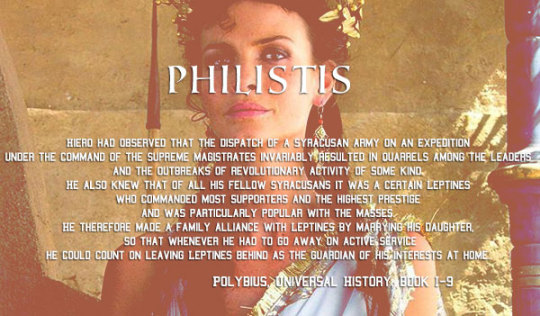
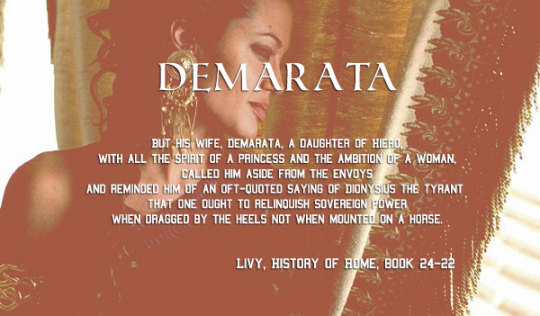
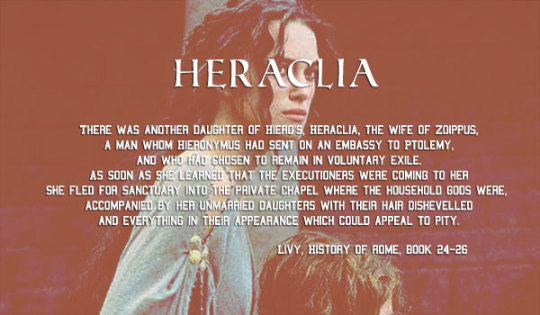
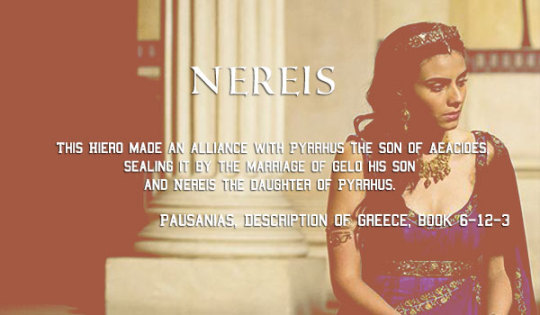

"For what," he [the praetor Sopater] asked, "could a boy like Hieronymus, who was hardly in his teens, have done on his own initiative? His guardians and masters reigned unmolested because the odium fell on another; they ought to have perished before Hieronymus or at all events when he did. [...] But it was really the wives who were responsible and who, being of royal blood, had filled their husbands with a passion for royalty, for one of the men had married Hiero's daughter, the other a daughter of Gelo." At these words shouts rose from the whole assembly declaring that neither of these women ought to live, and that no single member of the royal family ought to survive.
Livy, History of Rome, book 24-24
The Women of the House of Hiero II of Syracuse (3rd century BC)
Philistis was the daughter of an influential Syracusan citizen, Leptines. Through her father, she descended from Siceliot historian Philistus. Around 275 BC Philistis married Hiero, who will become tyrant of Syracuse in 270 BC. This man was the illegitimate son of a Syracusan nobleman, Hierocles. Hiero served under Pyrrhus I of Epirus during the Sicilian campaign, and after the King of Epirus left the Island, Hiero was appointed arcontes together with another man, Artemidorus. While the latter, at some point, simply disappeared from the chronicles, Hiero managed to establish a personal rule resembling the contemporary Hellenistic reigns. Philistis would give birth to three children: Gelo, Demarata and Heraclia. Nothing more is known about her life or death, although she’s portrayed in various coins minted during the reign of her husband. In these coins Philistis appears veiled and with idealized traits, resembling the type of Demeter, but also in the style of the coins of the Ptolemaic queens of Egypt.
Demarata was daughter of Hiero II and Philistis. Her name was chosen to honor late queen Demarete of Syracuse and in an attempt to link Hiero’s dinasty to previous tyrant Gelon’s, from whom Hiero declared to descend. Demarata married Adranodoros, one of Hieronymus’ fifteen guardians and part of the pro-Carthaginian faction. Hieronymus was Hiero’s grandson and heir as well as Demarata’s nephew and became Syracuse’s tyrant after his grandfather’s death in 215 BC. Taking advantage of his nephew’s young age (he was 15 at that time), Adranodoros concluded an alliance between Syracuse and Carthage, thus betraying Rome. Moreover he dismissed the other guardians and became Hieronymus’ sole ward with the title of chief counsellor. Hieronymus was killed (stabbed to death) in 214 BC in Leontini by a band of conspirators led by the Syracusan Deinomenes. He had ruled for just 13 months. At first, Adranodoros attempted to seize the power and become the new tyrant. When he understood it was too difficult and risky, he surrendered the power to the Syracusan people and was appointed general. But soon the people became wary of Adranodoros, especially after Ariston, a comedian and friend of the general, declared that Adranodoros and Themistos (brother-in-law of the late Hieronymus) were plotting to massacre the other influential citizens to establish their personal tiranny. Syracusan senate then gave order to eliminate the threat and so Adronodoros and Themistus were killed as soon as they entered the Senate building in 214 BC. Not satisfied with just those two murders and with the intent to justify his decision, the other general Sopater (member of the pro-Roman faction) accused the two men’s wives. In particular, Demarata was depicted as ambitious and power-hungry. She was accused of being the real mastermind behind the idea to remove Hieronymus’ other guardians, as a matter of fact starting Adranodoros’ scramble for power. Demarata’s supposed (or not) aspiration to become Syracuse’s queen was shattered the moment she was killed by the angry mob incited by Sopater’s accusations.
Heraclia was daughter of Hiero II and Philistis, as well as sister of Demarata and Gelo. She married Zoippus, who together with Adranoros was one of his nephew Hieronymus’ guardians. Like his brother-in-law, Zoippus was part of the pro-Carthaginian faction and worked to distance Syracuse from Rome. He was sent to a diplomatic mission to Ptolemy (most certainly Ptolemy IV Philopator). When in 214 BC Zoippus was reached by the news of Hieronymus’ death, he decided to remain in Alexandria in a self-imposed exile and so he survived his family’s massacre. His wife, Heraclia, and his two unnamed daughters weren’t equally lucky. No importance was given to the fact they were extraneous of plots and political schemes, what mattered was they were members of the royal family. They seeked refuge in a temple, hoping the mob would have respected the sacrality of the place. Heraclia implored the crowd to at least spare the girls, who were so young and innocent and just kill her. She was dragged outside the temple and killed before her daughters’ eyes with her blood splattering them. The girls, at first, managed to resist, but in the end they fell lifeless to the ground with their bodies full of wounds and whole place was covered in their blood. Soon after a messenger arrived with the order they were not to be killed, but it was already too late.
Nereis was an Epirote princess and the daughter of Pyrrhus II of Epirus and an unnamed woman. Her sister Deidameia was the last Aeacid sovereign of Epirus. Nereis descended from both Pyrrhus I of Epirus (her great-grandfather) and the Syracusan tyrant Agathocles (her great-great-grandfather). Her marriage to Gelo, Hiero’s son, was part of her father-in-law’s policy to strenghten and validate his dynasty. A similar alliance had been established in the past, and Nereis was the result of it. The marriage pact was concluded just before the fall of the Aeacid dynasty. The princess bore at least two children to Gelo, a girl and a boy: Harmonia and Hieronymus. Nothing is known about her fate, but it’s implied she survived her sister, making Nereis the last surviving Aeacid royal member.
Harmonia was the only daughter of Gelo of Syracuse and Nereis of Epirus. This made her the granddaughter and then the sister of the last two Syracusan tyrants. She married Themistos, member of the pro-Carthaginian faction and possibly one of the 15 guardians of Hieronymus. Themistos was accused together with Adranodoros to aspire to a personal tyranny following the murder of his brother-in-law and then killed. Like her aunt Demarata, Harmonia was considered a schemer and a puppetmaster of both her husband and young brother. After the murders of her aunts and cousins, it was only a matter of time Harmonia would have followed them. Her nurse then found a girl of the same age and resembling her protegée. The girl accepted to pass off the princess and was dressed in royal attire by the nurse, then she proceded to draw all the attention to her. In the meantime, Harmonia went hiding, but seeing the murderous crowd killing the innocent girl was too much for the princess. Tradition says she killed herself, although according to Valerius Maximus she revealed herself in front of the killers, claiming to be the real Harmonia, and was instantly murdered.
#women#history#women history#historical women#sicily#Philistis#Demarata#Heraclia#Nereis#Harmonia#hiero ii of syracuse#hieronymus of syracuse#greek sicily#people of sicily#women of sicily#siracusa#province of siracusa#historyedit#myedit
64 notes
·
View notes
Photo

Agathocles, therefore, when the pain of his disease and his anxiety of mind were grown intolerable, the one being increased by the severity of the other, resolved on embarking his wife Texena, and two infant sons that he had by her, with all his treasure, and servants, and regal furniture (in which no king at that time was richer), and sending her back to Egypt, from whence he had received her, fearing that they would find the usurper of his power their enemy. His wife, however, long entreated that she might not be separated from her sick husband, that the affliction of her departure might not be added to the atrocities of his grandson, and that she might not be made to appear as cruel in forsaking her husband as he in attacking his grandfather; saying that, “by marrying him, she not only engaged to share his good fortune, but all his fortune; nor would she unwillingly purchase, with the hazard of her own life, the privilege of receiving her husband’s last breath, and of performing, with all the care of conjugal duty and affection, the last offices at his funeral; which, when she was gone, no one would take upon himself to discharge.” The little children, at parting, embraced and clung to their father with doleful lamentations; while the wife, who was to see her husband no more, could not desist from kissing him. Nor were the tears of the old man less moving; the children wept for their dying father, the father for his banished children. They bewailed the forlorn condition of their parent, a sick old man; he lamented that his offspring, born to the prospect of a throne, should be left in want. At the same time the whole palace resounded with the cries of those who were witnesses to so cruel a separation. The necessity for departure, however, at length put a stop to their weeping, and the death of the prince followed the leave-taking of his children.
Marcus Junianus Justinus, Epitome of the Philippic History of Pompeius Trogus, book 23, 2
Theoxena (also known as the Younger or Theoxena of Egypt to distinguish her from her mother) was a Siceliot princess born in Syracuse in the 2nd half of IV century BC. Her parents were Agathocles, tyrant of Syracuse and later basileus of Sicily, and his third wife the Greek-Macedonian princess Theoxena. She had a full brother, Archagathus, and four half siblings (Archagathus, Agathocles, Heracleides and Lánassa) from her father’s previous marriages. Her maternal grandparents were the Macedonian princess Berenice (greatniece of general and Regent Antipater of Macedonia and later second Ptolemaic queen of Egypt as spouse of Ptolemy I) and her first husband Philip, an obscure Greek Macedonian nobleman who had served under Alexander the Great.
Before dying in 289 BC, Agathocles disposed for his wife and younger children to leave Syracuse and seek shelter in Egypt. The basileus feared that his grandson Archagathus (son of his first born Archagathus), after killing his uncle Agathocles, might have decided to harm the queen Theoxena and the younger princes.
The young Theoxena and her brother spent then their youth in Egypt, at the court of their grandmother Berenice I and her husband Ptolemy I.
At some point, the Syracusan princess married a man whose name is lost and gave birth to two children: a child whose name too was unrecorded and a boy called Agathocles after his grandfather.
During the reign of Ptolemy II, a son of Ptolemy I and Berenice I (283 BC -246 BC), Theoxena was sent to exile to the region of Thebaid, perhaps in Coptos. She had falsely accused some people she knew in the presence of her half uncle the pharaoh. Regrettably, the names recorded on a papyrus were lost after it was damaged. It’s possible that Theoxena’s banishment is to be linked to the exile of Ptolemy’s wife Arsinoe I. Accused of plotting against her husband, the queen was repudiated and convicted in exile in Coptos. It is extremely likely that the one who managed to convince the pharaoh to banish his wife was Princess Arsinoe, sister of Ptolemy II and half-aunt of Theoxena. After that, Arsinoe would marry her brother and co-rule along with him as Queen Arsinoe II of Egypt.
Nothing is known about the fate of Theoxena.
#theoxena the younger#women history#women#history#women in history#agathocles of syracuse#theoxena of syracuse#greek sicily#siracusa#province of siracusa#people of sicily#women of sicily#myedit#historyedit
60 notes
·
View notes